




By Leo Adam Biga
Celebrating 100 years with the 2024-2025 season, the Omaha Community Playhouse (OCP) has a mission of opening the world of make-believe to everyone. True to its community-based model the nonprofit depends on volunteers to fill on-stage and behind-the-curtain roles. For a century now people from all walks of life, including professionals, students, homemakers and retirees, have put their ordinary lives on hold to make theater there. Some build and paint sets. Some work the box office. Others ushergreet. Still others act, sing, dance, stage manage. Few make it their livelihood. But a select few do use it as a stepping stone to theater careers. Some paths even lead to Broadway and beyond.
This centennial season some star alums and other Omaha talents who’ve found success in New York are helping the theater celebrate its centennial. On Feb. 1 two-time Tony Award winner Norbert Leo Butz (Rent, Wicked, Dirty Rotten Scoundrels), who acted on the Playhouse mainstage and in the touring Nebraska Theatre Caravan, performed his Broadway, My Way

revue as a tribute. Special guest star and Omaha native Pat Hazell, a comic, actor and playwright, joined him. Hazell’s one-man shows and plays have been produced at the Playhouse. In a rare dramatic turn, he starred in its production of A Few Good Men.

Therapy dogs provide numerous benefits to those they serve, including providing comfort and support, and reducing stress
Learn more about therapy dogs on Page 16.
On April 5 Omaha native and Tony Award-winner John Lloyd Young (Jersey Boys) headlines OCP’s Century Gala nearly four decades after he played Young Scrooge in its A Christmas Carol. All three artists credit the Playhouse with making a difference in
their careers. Butz called it “foundational.” Lloyd, “formative” and “eye-opening.” Hazell, who grew up seeing shows there, then helped build flats and paint sets, before acting and producing work at OCP, said, “I learned a lot.”
Other Playhouse veterans have offered congratulatory notes and reflected on its legacy. Omaha native Broadway veteran Q. Smith made her only Playhouse stage appearance in Oklahoma while still a North High School student.
“It was a cool experience,” she recalled. “Everyone was much older than me and very professional. I had a great time.”
COMMUNITY MAKES IT GO
Resilience is a recurring theme in the Playhouse story, as it’s survived wars, economic crises and the pandemic. When health officials prohibited indoor events during the Covid outbreak the theater took a cue from its post-tornado experience to stage shows al fresco. Crowds turned out.
Enduring community support has gotten the Playhouse through thick and thin.
--OCP continued on page 9.
Thinking about hitting the road with your friends and family for a Nebraska football road game?
Look no further than what the Good-Life Tours has to offer when it comes to seeing the Nebraska Cornhuskers in action on the gridiron.
“We typically get 50 to 60 people on each of our trips, and a lot of our customers are repeat customers,” co-owner, Gary Mixan said. “People know what product they are going to get, and we listen to what the people want to do and where they want to go.”
It began in 1998 when Gary Mixan and Bob Kment decided they were going to Kansas City to watch Nebraska take on Oklahoma State at Arrowhead Stadium.
The two former high school classmates realized a lot more people
were wanting to go, so they decided to work together and planned a trip.
“For whatever reason, everyone wanted to go to the game at Arrowhead and people came up to me asking for tickets, a hotel and a bus,” Bob Kment said. “We took a bus of 50 people down there and we had a great time.”
It was at that moment when Kment and Mixan knew they had enough connections and resources to come up with ways to go on trips for future football games.
Every year, the two would look at the upcoming football schedule and decide which destination most fans would want to attend. They would look at the destination, and the time of year of when the games were and then would come up with a plan of what to do in the days leading up to the game.
--Football continued on page 8.

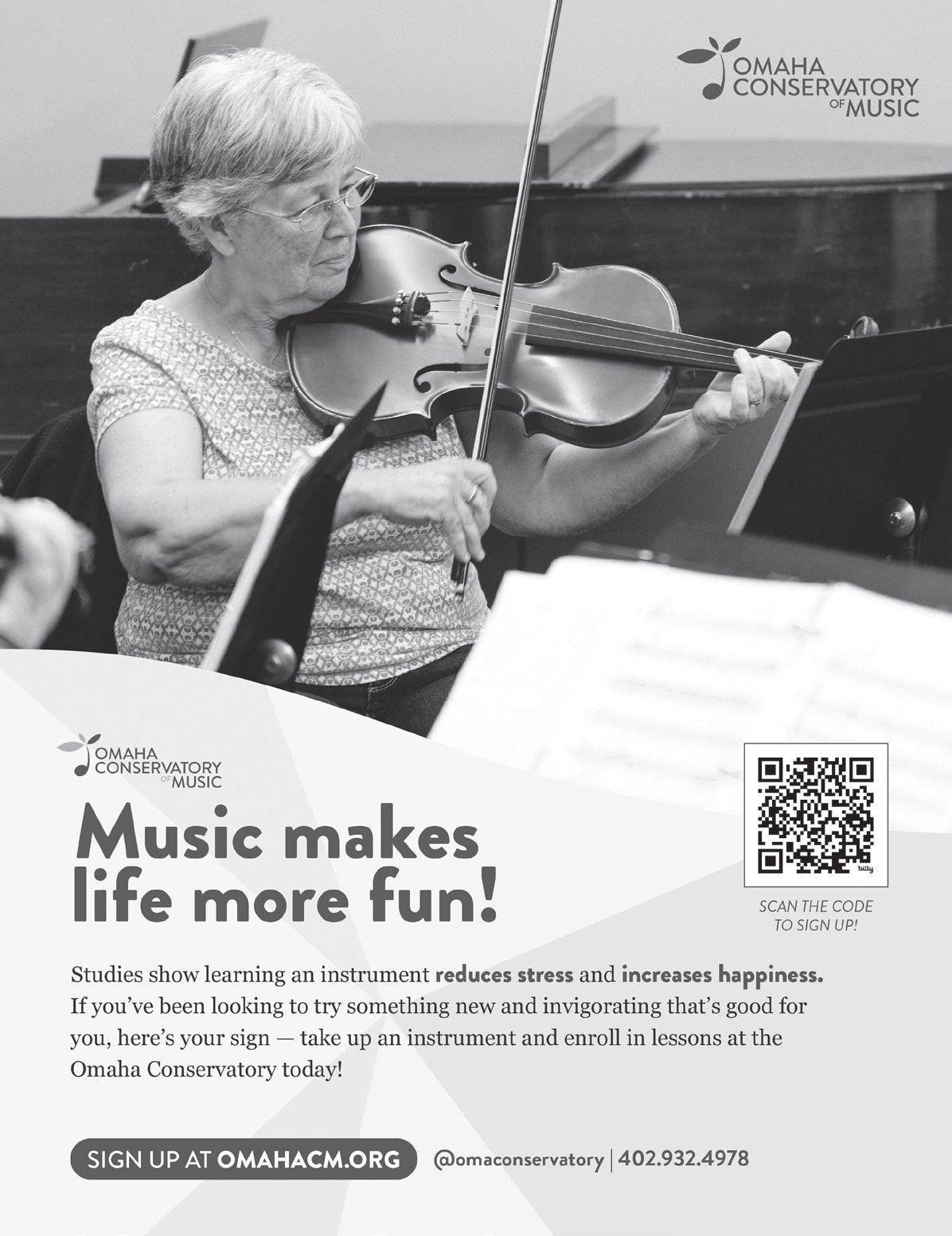

By Kelly C. Bourne
Every piece of software ever written has errors in it. Some errors are found and removed during testing, but others slip through the testing process and stay hidden even after the program is sold, installed and widely used.
The larger a program or application the more errors it is likely to have. The number of lines of code that make the modern world function is staggering.
• Desktop operating systems have tens of millions of lines of code. Windows 11 has about 50 million lines of code. Apple hasn’t released a line count of its latest operating system, but the Mac OS X 10.4 had an estimated 86 million lines of code when it was released in 2007.
• Android and iOS, used in cell phones, each have about 12 million lines of code.
• Business applications are also extremely large. Microsoft Office, for example, has over 100 million lines of code.
• Browsers used to access the Internet are also large. Google Chrome and Mozilla Firefox each have around 32 million lines of code.
• Modern video games have enormous code bases. Grand Theft Auto V is estimated to have around 100 million lines of code.
Errors in production software leads to many problems. Some of these are:
• Logic errors can cause applications to behave unpredictably. In the worstcase scenario these errors can make the application or even the entire computer crash.
• Performance issues cause a program to run more slowly than expected, leading to user frustration.
• Security related errors can be exploited to make applications do things they shouldn’t do. This can include giving users access to data they shouldn’t have or allowing them to make changes they shouldn’t be able to make.
Software vendors like Microsoft, Apple, Facebook and Google are constantly testing their code to find and correct errors. They create and release patches and updates so the code being run by their customers functions correctly. A patch fixes a
specific bug or vulnerability. An update is a collection of changes that can fix bugs, provide new features or address performance issues. All software eventually requires updates. The most important types of software for consumers to keep upgraded are:
• Operating systems like Microsoft Windows, Apple iOS & macOS and Google Android that run desktops, laptops, tablets and cell phones.
• Internet browsers like Mozilla Firefox, Microsoft Edge, Google Chrome and Apple Safari.
• Cell phone apps like Instagram, Facebook, Google Maps, Uber and WhatsApp.
• Desktop applications like Adobe Acrobat Reader, Telegram, Google Photos, TeamViewer and WhatsApp.
• Security and antivirus packages like Norton Antivirus Plus, McAfee Advanced, NordVPN and Bitwarden.
Not all applications used by consumers are loaded onto their devices. For example, Microsoft 365 is used for word processing or spreadsheet calculations, but it isn’t loaded onto a consumer’s computer. It runs on a Microsoft server that the user’s computer connects to via the Internet. Applications that run on vendor servers are referred to as “Software as a Service” or SaaS. When errors are found in a SaaS application the vendor updates the software on their servers. Consumers don’t have to download any updates.
Examples of consumer software that runs as an SaaS model include:
• Google Workspace –email and word processing applications
• Online games like Fortnite, World of Warcraft, Call of Duty and Grand Theft Auto Online
• Zoom – video conferencing
• Netflix – video streaming service
• Spotify – video audio streaming service
• Dropbox – cloud storage
• QuickBooks Online and TurboTax Online – accounting and tax apps
Each vendor has its own cycle for releasing patches and updates. Adobe, Microsoft, Oracle and some other vendors release updates
and patches on the second Tuesday of every month. The unofficial term for this day is, “Patch Tuesday.” Other vendors release updates only when they’ve accumulated multiple changes. If a critical vulnerability needs to be corrected immediately, a patch will be released by the vendor as soon as the fix has been written and tested.
Steps users can take to update software on their computers and phones are:
• iPhone iOS operating systems can be updated by accessing Settings > General > Software Update. If an update is available a button labeled, “Update Now” will be displayed.
• Android phones can be checked by tapping Settings > System > Software update. If an update is needed, then instructions will be provided on the screen.
• Microsoft Windows computers can be checked by going to Settings > Update & Security. On the “Windows Update” screen if an update is available a button labeled “Download and install” will be displayed.
• Mac computers can be updated by selecting the Apple menu in the upper left corner of the screen. Click System Settings > General > Software Update. Click the “Update Now” button to download and install any update that is available.
• iPhone apps can be updated by selecting the “Apple apps” icon on the main screen and then on the App Stored icon. If apps need to be updated the circle with your profile initials in the upper right corner of the screen will have a number displayed on it. Press the profile initials. The next screen displayed will list all applications that need to be updated. Click the “Update All” option or select “Update” for the specific app(s) you want to update.
• Android phone apps can be updated by opening the Google Play Store app, tapping on the profile icon and then tapping on “Manage apps & device”. Apps that need updating will be displayed. You can select “Update all” or click on the specific app(s) you want to update.
Users can have patches and upgrades installed automatically as the vendor
--Software continued on page 3.
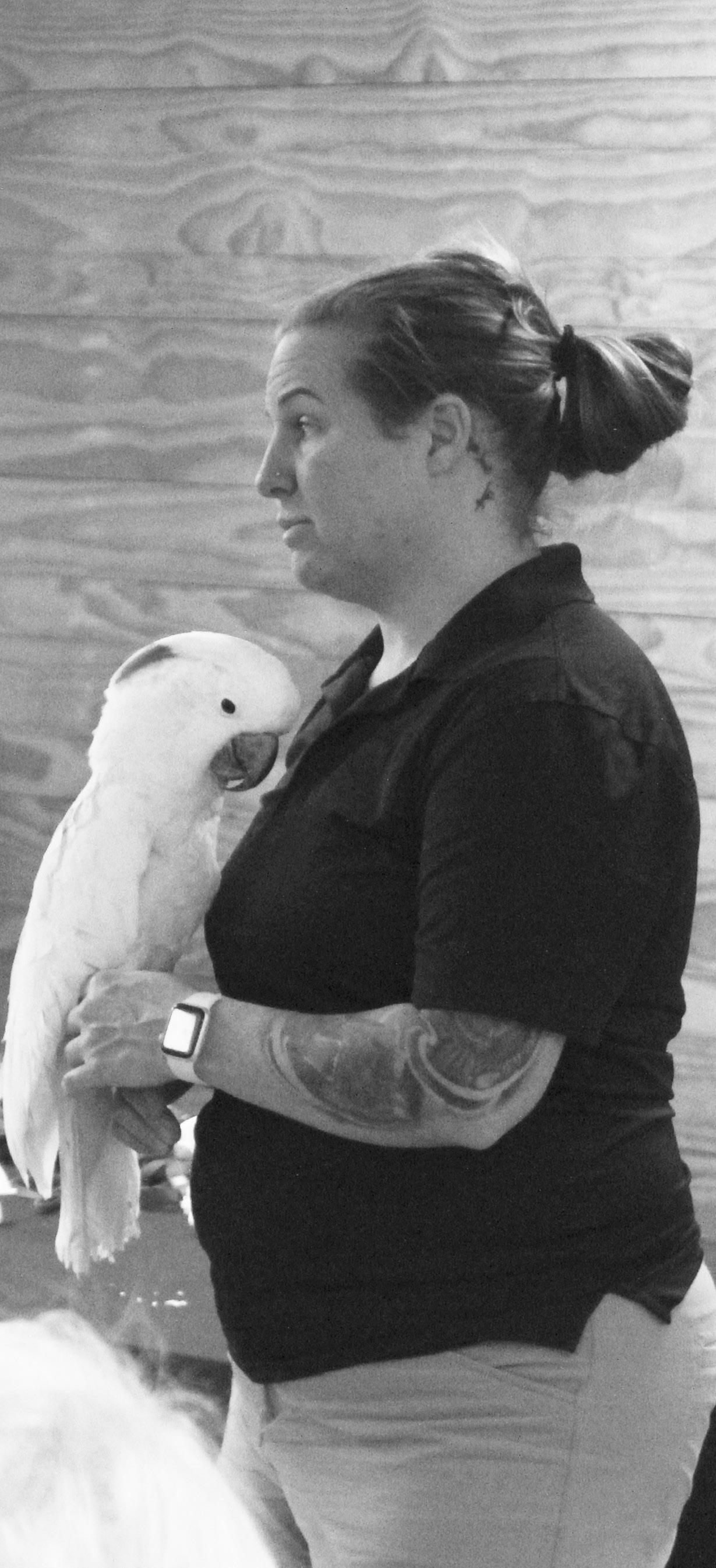
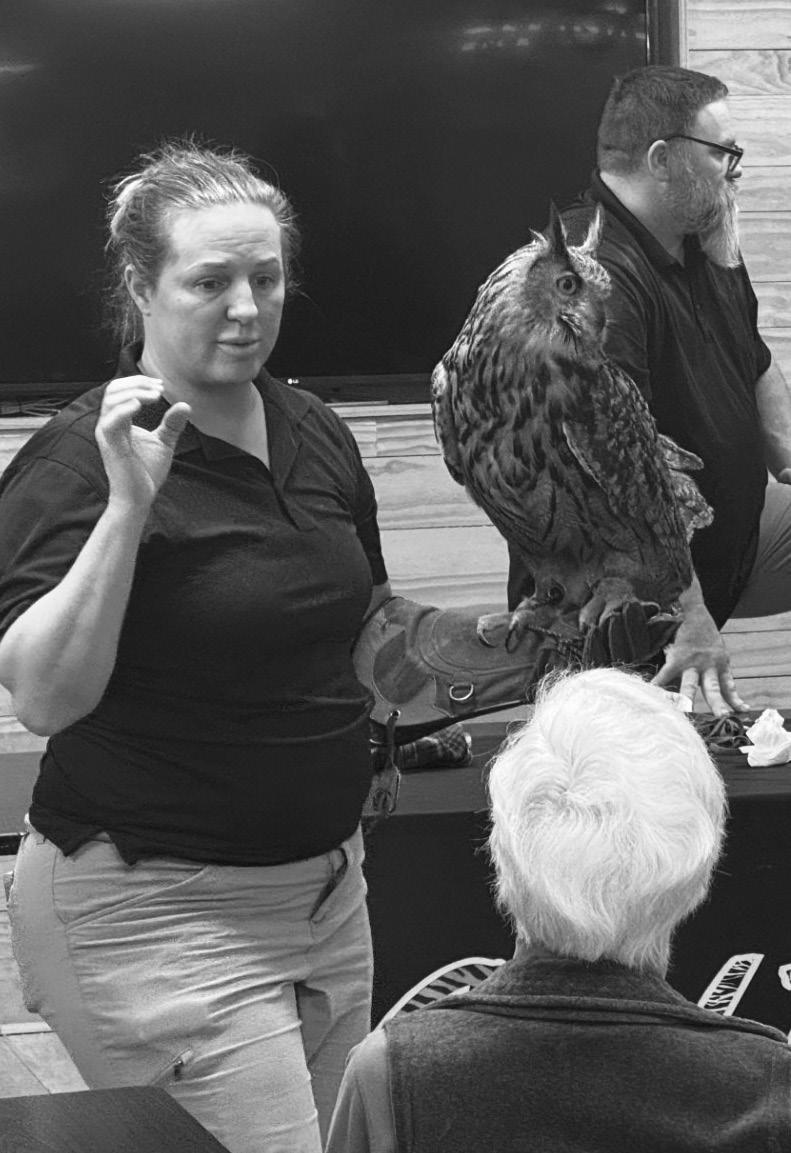
HORIZONS PHOTOS
In February, Critter Close-Ups brought a few of their exotic animals to the Seven Oaks Senior Center, on 3439 State St. The locals were able to see and touch animals like a capuchin monkey, moluccan cockatoo (left), sugar glider, fennec fox, owl and a bunny named, “Waffles.”
Have you ever said something you later regretted or been so nervous you couldn’t sleep? Have you walked into a room and forgotten what you were looking for?
Most people can relate to these scenarios and, just as well, could benefit from incorporating more mindfulness practices to our lives.
WHAT IS MINDFULNESS?
Mindfulness and meditation are words that can stir up a lot of confusion when we hear them.
Mindfulness is the psychological process of purposely bringing one’s attention to experiences occurring in the present moment without judgment, which one develops through
the practice of meditation and through other training. So, what does that mean for you? Mindfulness can bring better sleep, improved focus, reduced stress, among many more benefits.
MINDFULNESS PRACTICES
There are many misconceptions about mindfulness and meditation that make people think it is a religious practice or that it’s all about clearing their mind and thinking “nothing” or that it always involves being still.
There are numerous ways to bring these practices to your daily life that are accessible to everyone and the benefits are definitely worth your time.
• When thoughts, feelings or sensations emerge, do
Software continued from page 2.
releases them. Desktops, laptops, tablets and cell phones can be set to install updates automatically. Providing instructions for setting this up for every device is beyond the scope of this article, but a quick Internet search can show how it can be done for your device(s). Ideally consumers should set their devices to automatically download and install changes when they are released. Ignoring patches and updates opens you up to numerous risks. The biggest one being
not ignore them or suppress them, nor analyze them or judge them. Welcome them with curiosity, then let them go.
• Simply note any thoughts as they occur and observe them intentionally but non-judgmentally, moment by moment.
• Use the breath as a tool to anchor you to the present moment. Take deep, regular breaths.
When we anchor our awareness in the present moment, joy, contentment and gratitude can be found as well.
Submitted by Karen Rehm, worksite wellness specialist. To contact Karen at 402-483-1077 or send an email to krehm36@gmail. com.
that cybercriminals actively research security vulnerabilities when patches and updates are released to find ways to exploit them. If you don’t install updates and patches, then your computer or cell phone has flaws that make them vulnerable to attack.
Kelly’s newest book, Ransomware, Viruses, Social Engineering and Other Threats: Protecting Your Digital Assets will be available from Mercury Learning and Information in April, 2025.

New Horizons is the official publication of the Eastern Nebraska Office on Aging. The paper is distributed free to people over age 60 in Douglas, Sarpy, Dodge, Washington, and Cass counties. Those living outside the five-county region may subscribe for $5 annually. Address all correspondence to: Ron Petersen, Editor, 4780 S. 131st Street, Omaha, NE 68137-1822. Phone 402-444-6654. FAX 402-444-3076.
E-mail: ron.petersen@enoa.org
Advertisements appearing in New Horizons do not imply endorsement of the advertiser by the Eastern Nebraska Office on Aging. However, complaints about advertisers will be reviewed and, if warranted, their advertising discontinued. Display and insert advertising rates available on request. Open rates are commissionable, with discounts for extended runs. Circulation is 9,000 through direct mail .
Contributing Writers
402-444-6654
Biga & Andy Bradley
ENOA Board of Governors: Mary Ann Borgeson, Douglas County, chairperson; Don Kelly, Sarpy County, vice-chairperson; Lisa Kramer, Washington County, secretary; Pat Tawney, Dodge County, & John Winkler, Cass County.
The New Horizons and the Eastern Nebraska Office on Aging provide services without regard to race, color, religion, sex, national origin, marital status, disability, or age. Editor.
By Andy Bradley Contributing Writer
Think of it as your passport to the pearly gates. Your golden ticket to the life beyond.
These are your documents that ensure your final wishes are granted. Not by a genie. But by those who manage your affairs when you can no longer do so yourself.
The activity of assembling those documents is generally referred to “getting your affairs in order.” Only, you don’t want to

wait until your affairs are in disarray to do so.
There are as many as five documents that comprise this portfolio.
• A healthcare power of attorney.
• A living will.
• A durable (or financial) power of attorney.
• Last will and testament.
• A trust.
Anne Marcotte, an attorney with legal Aid of Nebraska, described the importance of these documents at a forum March 14

Are you looking for senior living solutions, have financial or legal questions about the future, or are curious about healthcare options over age 55? Join us for a Senior Fair where local vendors will be convienently stationed in one place at one time!
Beautiful Savior Senior Activity Center 7706 S. 96th St. La Vista, NE 68128 Friday, May 16th | 9:00am-12:00pm
Have questions? Contact Dawna Nikiema, Beautiful Savior’s Senior Activity Center Director, at 402.331.7376 or sac@bslcomaha.org.


• One Floor Living
• Open Concept” design – easy traffic flow
• Step-less Front Door & Garage Entries
• Wider Hallways

at the University of Nebraska-Omaha, sponsored by the Department of Gerontology.
A healthcare power of attorney identifies a person, often a spouse, adult child or other family member, to manage your health care needs and to make critical health care decisions when you are incapacitated. “You need to do this before you need it, while you still have capacity,” Marcotte advised.
A living will is a companion document. It outlines your end of life medical treatment preferences. This includes medical interventions such as resuscitation, feeding tubes, ventilators, and other extraordinary measures.
A durable power of attorney identifies your agent to manage financial affairs when it becomes burdensome to do so. Often the need for this POA becomes apparent when unopened bills and past due notices pile up haphazardly on a desk, or when someone is totally lost utilizing technology that they previously mastered. This POA “authorizes another person to make decisions for you,” said Marcotte.
Last will and testament describes the desired disposition of property upon your death. This includes major items such as your home and vehicles, as well as personal property such as jewelry, heirlooms, furniture, clothing and other personal effects. The will stipulates the people, and perhaps charitable organizations, who will receive your legacy, including how much goes to each.
Your explicit wishes and
instructions for a funeral or memorial service can also be included, as well as how you want your so-called “digital assets” handled –this includes the disposition of any Facebook, Instagram, email or other electronic accounts.
The will also identifies your designee for settling the estate. Known as an executor or personal representative, this person is empowered to pay all bills, including final medical expenses, distribute all property, and close all accounts. In the absence of a will, the courts may determine the disposition of property through a process known as probate. This may happen when a creditor, family member or other party disputes how property and final assets are being distributed. Nebraska law allows for a simpler probate process for smaller estates.
The final document, a trust, is a failsafe vehicle for avoiding probate. Think of a trust as a vase – a receptacle or placeholder for protecting your assets. Essentially, the property identified in your will is offloaded into the trust. This affords a high degree of legal protections and safeguards, ensuring that your final wishes are carried out. The trust is basically the owner of the assets, and beneficiaries of the trust are identified in the document. There are several types of trusts, and legal help may be necessary to prepare and execute.
Combined, these components comprise your estate plan. While they can be developed separately and
independently over time, it may be best to assemble all documents at once. Templates for powers of attorney and last will and testament can be provided free of charge through Legal Aid. And most medical facilities will offer templates for living wills. While most of these documents can be prepared without legal counsel, an attorney can be valuable when circumstances are more challenging, especially for the preparation of a trust. Legal fees can exceed $1,000. Legal aid can prepare POAs and simple wills for lower income Nebraskans.
The Legal Aid website – legalaidofnebraska.org –offers multiple resources to assist with the preparation of these important documents. But seniors can also talk to a live voice through its ElderAccessLine by dialing 1-800-527-9249. Guidance can be provided on a host of issues, including Medicare, Medicaid, consumer protections, simple wills, power of attorney, Homestead exemption, tenant issues, and others.
This Wills and Power of Attorney Fundamentals program was part of the Begin With the End in Mind series sponsored by the UNO Department of Gerontology. The next program, To Die Well, features Dr. Steve Doran, a neurosurgeon, author and deacon for the Archdiocese of Omaha. The April 11 program will run from 1-2 p.m. at the UNO Thompson Alumni Center. It will be simulcast on Zoom. Call (402) 554-2272 for more information or to register.
By Andy Bradley Contributing Writer
• Wider Doorways (most doors)
• Low-Curb or Zero-entry (per plan) Shower Access
• Low Maintenance Exteriors
• Available in over 20 Communities


www.RegencyHomesOmaha.com *This is Universal Design; not ADA Standards. Homes designed with your future in mind! Open concept floor plans with “Universal Design”* standards Locations available in all parts of the Omaha area For NW/Elkhorn Living: 402-916-9883 For SW/Gretna Living: 402-895-1100 For Papillion Living: 402-896-9200 For Bellevue Living: 402-614-6088
The UNO Department of Gerontology’s “Begin with the End in Mind” March 14 conference also provided practical cautionary advice related to fraud prevention.
Anne Marcotte of legal Aid Nebraska said unscrupulous agents prey on seniors by presenting either frightening scenarios (you owe back taxes) or dubious opportunities (you have won the sweepstakes). The online or telephone solicitor will then require two things – an immediate response (IRS agents or law enforcement will be at your door if you don’t comply) or (these winnings must be claimed
today) and a demand for money (e.g. we need your back account information and Social Security number to deposit your winnings).
Red flags! These urgent but bogus requests for money are fulfilled through gift cards, cryptocurrency, or solicited by siphoning into your bank account, especially via wire transactions. “They never want your credit card because that’s the one thing you can call and cancel easily,” Marcotte said. “Credit cards have significant fraud protections.”
Marcotte cautioned attendees to be ultra vigilant when it comes to providing personal and financial information online or on
the phone. She said unscrupulous parties will pressure you to act, often in the guise of owing money to the government, including the IRS. Prevention is so key, because once this has happened, it is really hard to get the money back.”
The Consumer Protection Bureau of the Nebraska Attorney General office offers valuable consumer protection resources through its website, protectthegoodlife. gov. There are links to information related to a wide array of scams, including appeals by fake charities, grandchildren in “trouble,” home repairs, “expired” car
--Scams continued on page 5.
Stress Awareness Month has been recognized every April since 1992, but this year it seems particularly important.
Learning to cope with our stress and finding healthy ways to deal with these situations can go a long way in living a healthy and positive life.
What does stress mean to you?
We all experience stress – yet we may experience it in very different ways. Because of this, there is no single definition for stress, but the most common explanation is a physical, mental, or emotional strain or tension.
Stress is a reaction to a situation where a person feels anxious or threatened. Learning healthy ways to cope and getting the proper care and support can help reduce stressful feelings and symptoms.
Common reactions to a stressful event can include:
• Disbelief, shock and numbness
• Feeling sad, frustrated and helpless
• Difficulty concentrating and making decisions
• Headaches, back pains and stomach problems
• Smoking or the use of alcohol or drugs
AFFECTING MORE THAN JUST YOUR MIND
Long-term stress can prove to be more than just a mental issue. From headaches to stomach disorders to depression – even very serious issues like stroke and heart disease can come as a result of stress.
When you are placed in a stressful situation, specific stress hormones rush into your bloodstream leading to an increase in heart rate, blood pressure and glucose levels. This is helpful in emergency situations, but having this “rush” for extended periods of time can be dangerous and make you susceptible to the issues mentioned previously.
Sometimes the stress in our lives is not something we have the power to change. Try to:
• Recognize when you don’t have control, and let it go.
• Avoid getting anxious about situations that you cannot change.
• Take control of your reactions and focus your mind on something that makes you feel calm and in control.
• Develop a vision for healthy living, wellness, and personal growth, and set realistic goals to help you realize your vision.
Visit Fontenelle Forest for a tranquil and rejuvenating 2-hour session of Forest Therapy led by Shannon Gorres, MDiv, MA. Shannon is a certified nature and forest therapy guide with the Association of Nature and Forest Therapy. She has led hundreds of folks in discovering the beauty of their internal and external landscapes. See more about Shannon and her practice at www.DivineNatureTherapy. com.
The program starts with a 20-minute guided meditation and then continues with sensory invitations that explore the environment in a mindful and bodyful way. This structured sequence that brings us into deeper connection was inspired by the Japanese practice of Shinrin-Yoku. We bathe in the healing atmosphere of the forest.
They end with medicinal tea and sharing. Due to the relaxing nature of this event, they kindly request that participants are adults only.
--Scams continued from page 4.
warranties, internet hoaxes, investment frauds, sweepstakes or foreign lottery schemes.
The state of Nebraska’s State Unit on Aging will offer free consumer protection training this summer. Representatives from the Douglas County Sheriff’s Office, Better Business Bureau, the Office of Public Guardian
Here are some basic ideas to help you cope with stress:
• Take care of yourself –eat healthy, exercise regularly, get plenty of sleep, give yourself a break if you feel stressed.
• Share your problems and how you are feeling and coping with a family member, friend, doctor, pastor or counselor.
• Avoid drugs and alcohol. These can create additional problems and increase the stress you are already feeling.
• Recognize when you need more help – know when to talk to a psychologist, social worker or counselor if things continue.
Potentially the most valuable takeaway here is knowing how to talk to others about your stress. This goes both ways, as you need to know how to discuss your problems with others as well as talk to anyone that comes to you with their issues.
(Information provided by The American Institute of Stress).
ou’re invited to visit the La Vista Senior Center, located at 8116 Park View Blvd. The facility provides activity programs and meals Monday through Friday from 8 a.m. to 5 p.m. Please call 402-331-3455 for general Community Center hours.
Meals are served weekdays at 11:30 a.m. Reservations are due by noon the business day prior to the date the participant wishes to attend and can be made by calling 402-331-3455.
A $5 contribution is suggested for the meal if you are age 60 and older. If you are under age 60, then the meal cost is $9.50.
In addition to meals being served daily, the La Vista Senior Center offers a variety of activities such as: Bingo, outings, cooking classes, movies with popcorn, arts and crafts, a variety of card games, quilting, tai chi, exercise classes, musical entertainment and various parties. Please visit our website at cityoflavista.org/seniors for updated information or call 402-331-3455.
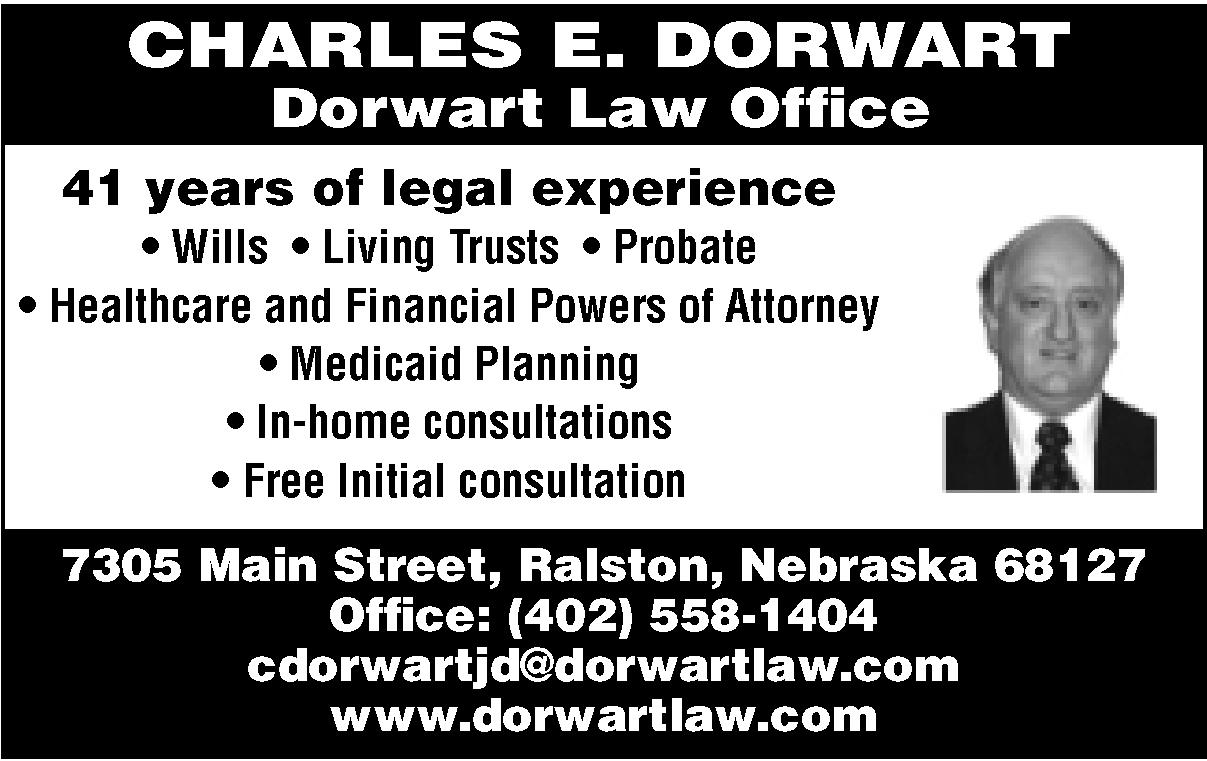
and others will be on hand for the Elder Justice Training program, August 13, 8:30 to 3:30, on the UNO campus. It will also be livestreamed from Nebraska Public media. The program is co-sponsored by the UNO Department of Gerontology, AARP Nebraska and Nebraska Area Agencies on Aging, among others. Additional registration details will be announced later.
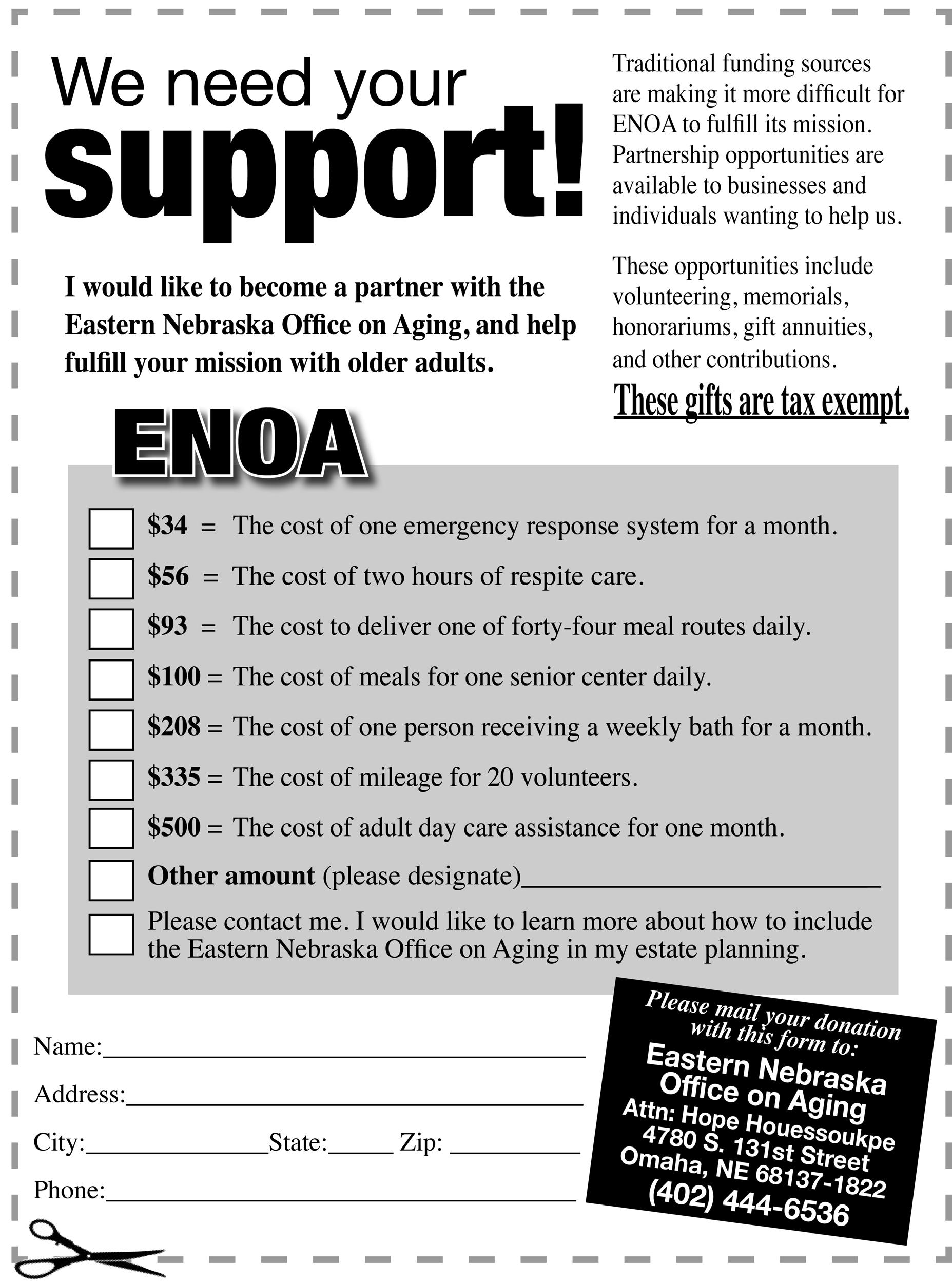
Please
$25 Josephine
$10
$5 Angie Marking
You’re invited to visit the Camelot Friendship Center, 9270 Cady Ave., for regular activities, which include Chair Yoga, card games, Tai Chi, Pinochle, 10 Point Pitch, and bingo. This month’s events include:
• April 4: Celebrate National Nebraska Day Trivia @ 12 p.m.
• April 5: National Nebraska Day – Celebrate with family & friends
• April 8: Entertainment with Joyce Torchia compliments of Merrymakers @ 11:45 a.m.
• April 9: Craft Day “Bunny Butt Pots” @ 12:30 p.m.
• April 16: Presentation & Trivia with Ann from Symphony of Care @ 11:45 a.m.
• April 17: Jackpot Bingo @ 12:15 a.m.
• April 19: Book Club @ 12 p.m.
• April 24: Presentation with Mary Parker from ENOA @ 11:45 a.m.
• April 29: Team Trivia Challenge @ 12 p.m.
Every Monday – Card Game: Manipulation @ 10 a.m.
Every Monday – Pickleball @ 10 a.m.
Every Tuesday, Wednesday and Thursday – Kings in the Corner @ 12:30 p.m.
Every Wednesday – Hand & Foot @ 12:30 p.m.
Every Wednesday – Chair Volleyball @ 10 a.m.
Grab N Go meals are available.
For more information, contact Barb at 402-444-3091 or barbara.white@cityofomaha.org.
Personalized moving solutions designed specifically for seniors and their families.

• We Organize pre-move
•
•
•
•
•
•
•
•
•
By Paula Crozier
Engaging in regular strength training and exercise is essential for older adults aiming to enhance mobility and flexibility. As we age, our bodies undergo changes such as muscle loss, joint stiffness, and decreased bone density, which can impair daily activities and increase the risk of falls. Incorporating targeted physical activity into your routine can counteract these effects, promoting independence and a higher quality of life.
According to a recent guest on the Mel Robbins Podcast, double-boarded Orthopedic Sports Surgeon Dr. Vonda Wright, MD, and author of best-selling book, “Guide to Thrive”, states that our American culture has aging all wrong. She states that we’ve come to believe that as we age, we should become weaker and we typically give up general exercise for the last twenty years of our life, in anticipation of dying. But that’s not the truth. Just continuing to move will lengthen our lives and continue building our strength.
Dr. Wright’s comprehensive approach to fitness is detailed in another book, “Fitness After 40: Your Strong Body at 40, 50, 60, and Beyond,” where she provides a sixweek plan designed to gradually enhance strength and mobility. This plan includes detailed resistance exercises, a mobility program, nutritional guidance, and timeefficient exercise routines, all tailored to help individuals maintain an active lifestyle as they age.
By integrating Dr. Wright’s recommendations into your fitness regimen, you can further enhance your journey toward improved mobility and flexibility. Her emphasis on strength training, proper nutrition, and regular physical activity aligns with the goal of maintaining independence and a high quality of life in older adulthood.
Recent studies underscore the significance of adapting exercise routines to address age-related physical changes. For individuals in their mid-60s and beyond, focusing on balance, flexibility, and strength training is crucial. Balance exercises, like heel-to-toe walks and standing on one leg, are vital for fall prevention. Flexibility practices, including yoga and tai chi, help reduce stiffness and back pain, enhancing overall mobility. Importantly, engaging in resistance exercises three to four times a week is
recommended to maintain muscle mass and power.
To embark on a strength training journey, start with your physician’s recommendation, and it’s advisable to start with simple exercises that utilize body weight or light resistance bands. Exercises such as squats, wall push-ups, and seated leg lifts can be effective initial steps. Consistency is key; performing these exercises two to three times per week can yield noticeable improvements in strength and flexibility within six to eight weeks. It’s essential to listen to your body and progress at a comfortable pace, potentially under the guidance of a fitness professional.
Incorporating outdoor activities not only enhances physical health but also provides mental rejuvenation. Omaha offers several venues ideal for older adults seeking to stay active amidst nature. For instance, Fontenelle Forest provides numerous hiking trails suitable for various fitness levels, allowing individuals to engage in low-impact aerobic exercises while enjoying the serene environment.
Similarly, Lauritzen Gardens offers gentle walking paths through beautifully landscaped areas, combining physical activity with the enjoyment of horticultural displays. Our award-winning Henry Doorly Zoo offers all day walking amongst the world-renowned habitats where learning is fun! Another excellent option is the Chalco Hills Recreation Area, which features seven miles of walking trails encircling Wehrspann Lake. These trails offer a scenic setting for walking or jogging, promoting cardiovascular health and joint mobility. Engaging in such outdoor activities not only contributes to physical well-being but also provides opportunities for social interaction and connection with the community while incorporating strength training and regular exercise into your lifestyle is a pivotal step toward maintaining mobility and flexibility as you age.
Paula is the Director of Marketing and Development at Florence Home Healthcare Center, Royale Oaks Assisted Living and House of Hope Assisted Living and Memory Care. In her spare time, Paula is rediscovering all the things she did as a child that she can still do like painting, coloring, hiking and bike riding.
By Tony Harris AARP NE Information Center
Spring in Nebraska means spring storms. Unfortunately, these storms can sometimes turn destructive.
On April 16 at 1:30 p.m., anyone is invited to attend the AARP Nebraska Information Center’s monthly program, “Prepare and Plan for Spring Storms,” with

experts from the American Red Cross who will talk about being aware about potentially damaging weather, the things you can do to be prepared for an emergency, and what to expect following a destructive storm like a tornado. Located at 1941 S 42nd St. in suite 220, the Information Center is open on
Tuesdays, Wednesdays and Thursdays from 10 a.m. until 4 p.m.
If you are interested in becoming more involved, stop by the Information Center to learn more about the many opportunities to get involved in the community by becoming an AARP Nebraska volunteer.
For more information call the Information Center at 402-916-9309.
The Intergeneration Orchestra of Omaha (IGO) is celebrating its 40th anniversary this year.
The annual IGO Spring Pops concert will be held on April 13 at the Omaha Conservatory of Music, located on 7023 Cass St.
The year’s featured guest artists are IGO alumni: Rebecca Teater, Ann Thiemen, Melissa Tatreau Holtmeier, Tom Miller, Spencer Feldman and Parker Wolfe. Doors open at 2 p.m. for the concert at 3 p.m.
You’re invited to visit the Fremont Friendship Center, 1730 W. 16th St. (Christensen Field). The facility is open Monday through Thursday from 9 a.m. to 3 p.m. and Friday from 9 a.m. to 12:30 p.m.
A meal is served weekdays @ 11:30 a.m. Reservations, which are due by noon the business day prior to the meal the participant wishes to enjoy, can be made by calling 402727-2815. A $4.25 contribution is suggested for the meal.
This month’s activities will include:
• April 2: Music with the Arthrighteous Brother’s @ 10:30 a.m.
• April 3: Presentation from Nye @ 10 a.m.
• April 8: Casino Trip
• April 9: Music with Larry Marik @ 10:30 a.m.
• April 10: Mobile Library @ 9:30 a.m.
• April 10: Singalong @ 10 a.m.
• April 16: Music with Jerry Stingley @ 10:30 a.m.
• April 17: Nutrition News @ 10 a.m.
• April 22: Home Exemption Application Assistance @ 9 a.m.
• April 23: Music with John Worsham @ 10:30 a.m.
• April 24: Eco-Fair Volunteers join the center for lunch
• April 30: “Quilt of Valor Presentation” @ 9:30 a.m.
• April 30: Music with Bill Chrastil presented by Merry Maker’s @ 10 a.m.
Craft class on Tuesday afternoons @ 1:30 p.m.
Tai Chi offered every Tuesday and Friday from 9:15-10 a.m.
If you can’t stay for lunch with our friends and you currently participate in any activity at the center, you may now order a Grab-n-Go meal to take home for your lunch. Grabn-Go meals must be reserved the day before by noon and the person ordering the lunch must come in to the center to pick it up at 11 a.m. The number of Grab-n-Go lunches are limited to a first come first serve basis. Suggested donation is $4.25.
For meal reservations and more information, please call Laurie at 402-727-2815.
You’re invited to visit the Millard Senior Center at Montclair, 2304 S. 135th Ave., this month for the following:
• April 2: Board Meeting @ 9:30 a.m.
• April 9: No P.A.W.S today: Spring break.
• April 9: Sewing Club meets to organize sewing projects for the Grain Train. They make sun dresses and shorts at home that are donated and distributed to several countries @ 9:30 a.m.
• April 11: Easter Pasta Pot Luck @ 11 a.m.
• April 14: Bunco @ 12:15 p.m.
• April 16: P.A.W.S (Puzzles, words with seniors working with Montclair Elementary kids) @ 9:30 a.m.
• April 17, 24: VAS (Volunteer Assisting Seniors) is doing a Homestead Exemption Application @ 9 a.m.
• April 18: Book Club: “Becoming Madam Secretary” by Stephanie Dray @ 1 p.m.
Our Panera Bread Fundraiser held in April Tai Chi on Mondays and Fridays @ 9:30 a.m. Bingo every Tuesday and Friday @ 12 p.m. Sportswear Fridays. Wear your favorite team attire every Friday.
Hand-N-Foot Wednesdays @ 8:30 a.m. MahJongg Wednesdays @ 1 p.m. Chair Volleyball Thursdays @ 9:30 a.m. Dominoes Thursdays @ 12:30 p.m.
For more information, please call 402-546-1270.



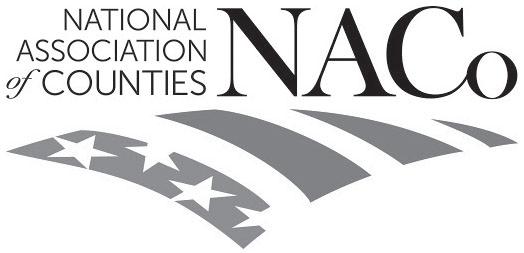
•
--Football continued from page 1.
“The key to our business is the location and hotel that we choose,” Mixan said. “You have to have a good location with stuff to do around the hotel. A lot of factors you have to plan is the cost of the bus, but everything is in position around the bus times. You’ll probably be on your own in the evenings.”
Most of the Good-Life Tours packages they offer will not only include tickets and hotel rooms, but they will plan activities to do leading up to the game like going to Ground Zero, the Reagan Library, the U.S. Capital, Arlington National Cemetery and Yosemite National Park. Even around meals, they may go to the local baseball game. They’ve been to games at Wrigley Field, Yankee Stadium, PNC Park (Pittsburg), Dodger’s and Angel’s Stadiums in Los Angeles, and Safeco Field in Seattle.
“We package a mini vacation,” Mixan said. “When we got into this, the football game was always a main draw even though Nebraska hasn’t been very good. We’ve figured out over the years is that if we are going to sell this, then we are going to sell the destination.”
With Nebraska moving from the Big 12 to the Big 10 in 2011, this allowed the Good-Life Tours to make trips to games around the country.
They’ve been to games played at Penn State, Wash-
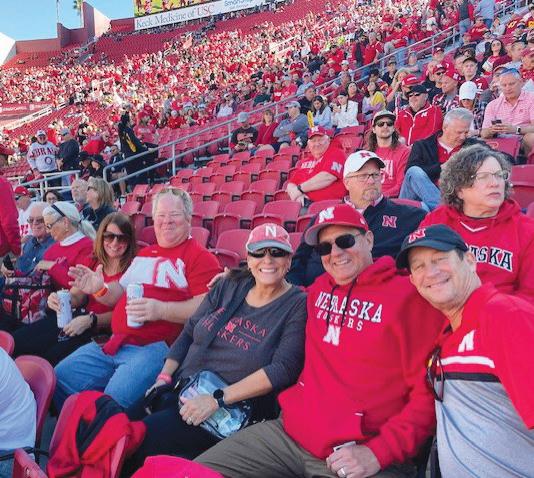
Sit back, relax and let Good-Life Tours plan your next Nebraska football road trip.
ington, Fresno State, Michigan, and many more. The Good-Life Tours groups have traveled to the Rose Bowl, Cotton Bowl, Holiday Bowl, Capital One Bowl, and all Big 12 and Big Ten Championship games.
“On the first trip to Notre Dame, a friend of mine met his future wife during the trip. They hit it off and they got married,” Mixan said. “It was easy to get people to come on the trips with us when Nebraska was winning.”
In a trip to Washington, they had over 120 people on a trip and then on a trip to Fresno, California, it didn’t go full as planned.
“After visiting Yosemite National Park, our bus broke down. Luckily, we had a food spot and had a great time while we waited for another bus to pick us up. It was crazy,” Kment said. “
In 2025, Good-Life Tours is planning three trips, which includes one trip that doesn’t involve a Nebraska football game.

head for the Nebraska game against Cincinnati, and then in October they are going to Washington D.C. for the Maryland game.
“We have a lot of people excited for the trip D.C. trip. It’s almost sold out,” Mixan said. “We have so much time to decide what to do and since we’ve been there before, it’s an easier trip to set up.”
While it may be tough to travel, Good-Life Tours always looks out for the customers to make sure they have a safe and enjoyable experience when it comes to the vacations they have planned.
“It’s been fun – we got into this because we wanted to go to the games. It dawned on us that we could make a little bit of money on it,” Mixan said. “It’s more relaxed – plus, older people enjoy the bus, they don’t have to deal with the stresses of flying.”
In the end of July, the Good-Life Tours are planning a five-night trip through Missouri, Kentucky and Illinois with stops at the Gateway Arch and Museum, a baseball game in St. Louis along with other museum tours along the way.
“We are venturing out of the football arena for the first time,” Kment said. “We are hoping for more of a family trip. People asked us to see if we could do a trip like this and now that we are retired, we now have more time to go on these trips. We might do one or two of those trips a year now.”
In August they are planning a trip back to Arrow-
Looking into the future, the two former classmates will continue to plan to go to two to three games a year, with the ultimate goal of having the chance to go to a National Championship game.
“In the upcoming years, we will probably go to Oregon, Washington and maybe even Rutgers, but the perfect scenario is that our last trip will be a trip to the National Championship game,” Kment said. “We’ve been to conference championship games, but that’s the closest game Nebraska has been to a championship game in the last 30 years.”
For more information, visit the Good-Life Tours website at goodlifetoursllc. com.
First United Methodist Church has some excellent adult curriculums available. They are free for any Christian group which would like to study prayer, discipleship and beliefs.
Call First United Methodist Church at 402-556-6262 if you wish to receive more information about the list of the studies available.
You’re invited to visit the Florence Senior Center, 2920 Bondesson St.
At the Florence Senior Center, lunch is served at 11:30 am. A select menu is offered Monday thru Friday. Meal reservations must be made one day in advance. Please call by noon the day before for a meal reservation.
The center hosts activites such as Tai Chi, annual picnics/ special events, bingo, cards, gym & game room access, special guest speakers and socials.
Arts and crafts will be held on the third Wednesday of each month. They also provide health and nutrition programs.
For more information, please call Colleen Metz @ 402444-6333.
“That is a testament to first of all the culture of Omaha, Nebraska and the community,” said Young. “It’s testament of love. I mean, there is a passionate feeling of community around the theater. I remember as a kid the people loved being there. People really put their heart and soul into it.”
Executive director Rebecca Noble acknowledges the critical role community plays at OCP.
“The Playhouse wouldn’t be in operation today were it not for a community which values the arts and its role in our lives. We’re a sizable organization, with a sizable building, two theater spaces, broad programming, and a staff. It’s not lost on us that it takes a great deal of support to maintain the level of quality we’re known for, to provide meaningful and impactful experiences, and to maintain operations.”
Volunteers, she said, are its lifeblood.
“OCP has hundreds of volunteers who provide much valued support across multiple areas. We have over 300 volunteers in our front of house alone (box office, ushers, greeters). This has trended down over the past 20 years and a number haven’t returned postpandemic. OCP isn’t alone in terms of the impact of the pandemic. Fortunately, our volunteer numbers have stabilized in the last two to three years.”
As arts organizations in a post-Covid world struggle to recapture patrons and to navigate diversity, equity. inclusion, accessibility issues, the Playhouse and theaters like it remain not only relevant but critical to developing new talents and audiences, Young said. “I think because it’s a community playhouse it’s more important maybe than a professional theater company because the doors are open (to everyone).”
He noted whereas most actors at regional theaters are professionals brought in from other parts of the country, at the Playhouse “your friends and neighbors are up there, so there’s more of a connection to the audience.” Added Young, “I think with these challenges theaters across the country face in attracting new audiences maybe the secret ingredient is more of that community involvement … actually community members being right up there on stage and really having skin
in the game. Maybe that’s the secret to revitalizing theater in general. With a community theater like the Playhouse it’s baked in and maybe that’s its salvation and greatest strength.”
FULL CIRCLE AND PAYING IT FORWARD
Young is happy to pay back what the Playhouse has kept giving him. Last fall the theater mounted Jersey Boys, the musical about pop singing sensation Frankie Valli and The Four Seasons that earned Young a Tony Award for his Broadway portrayal of Valli. He reprised the role in the Clint Eastwood directed feature film adaptation. “There’s nothing like a full circle feeling when you know in the centennial season of this place that gave you your start they did a production of a show you did first on Broadway. I mean, that blew my mind.” He promises Gala attendees will get their Jersey Boys fix when he performs hit numbers from the show.
Coming back to give back is a tradition at the Playhouse. Its first two star products, Nebraska natives Henry Fonda and Dorothy McGuire made their stage debuts there in the 1920s and 1930s, respectively. They returned at the height of their Broadway stage and big screen success to star in a 1955 production of The Country Girl. That show, which also marked the debut of Jane Fonda, raised funds for construction of the current Cass Street facility. Jane’s brother Peter Fonda acted there a few years later while attending Omaha University.
The Playhouse doesn’t take for granted former OCP artists returning, said Noble. “We’re always fortunate and humbled when they come home.”
As a theater kid at the Playhouse in the 1980s, Young took inspiration from photos in the lobby of legendary performers like the Fondas who preceded him there.
“I remember being really kind of enriched and energized by this history and the possibilities of a life in the theater.”
Dick Mueller and Terry Kiser, who shared an apartment in New York as struggling young thespians from Omaha trying to make it in the Big Apple, acted at the Playhouse when the Cass site was still new (the theater was previously on Davenport).
“The physical plant of

Tony Award winner, Norbert Leo Butz, recently performed at the Omaha Community Playhouse.
the Playhouse is so inviting with that wonderful main theater upstairs and small theater downstairs. Having that intimate studio or black box space for rehearsals and experimental works was very innovative in that time. You could practically scratch somebody’s nose in the audience,” said Kiser, who went on to win an Obie Award off-Broadway and earn a Tony nomination on Broadway.
“What a great environment to start off as a young kid.”
Mueller said even today the Playhouse, long known as the nation’s largest community theater is a unicorn for its spaciousness, high production values, extensive educational offerings, and sizable subscriber base.
Henry Fonda referred to the Playhouse as “the little theater,” not pejoratively but in reference to its roots in the Little Theatre movement of the early 20th century. Though an aunt was involved in the early Playhouse he had no interest in being a part of it himself. He only got involved at the prodding of Dorothy “Dodie” Brando, a founding member and the mother of future Broadway-Hollywood star Marlon Brando. The story goes, oft-repeated by Fonda himself, that while home from college and with few prospects the shy but strikingly handsome 20-year-old was recruited by Dodie to assume the juvenile lead the theater struggled casting for an upcoming play, Merton of the Movies. She in effect pushed him on stage and the rest, as the saying goes, is history.
Fonda recalled being so fascinated with stagecraft, just as Young was years after him, that he changed his career plan from journalism
to theater. After a season of theater making there Fonda left to continue his dramatic arts education on the East Coast, where he soon fell in with a group of young artists, including Joshua Logan, Margaret Sullivan and James Stewart, who contributed to his development. After leaving Omaha to hone his chops he returned to act opposite a prodigy, Dorothy McGuire, in the 1931 Playhouse production of A Kiss for Cinderella. Their appearance together anticipated the pair coming back two decades later, by then major stage-screen stars, for that Country Girl benefit run.
The Fonda-McGuire names became attached to Playhouse awards, programs and its black box theater. Each artist remained personally connected to the organization the remainder of their lives, particularly Fonda. He helped lead various fundraising campaigns. He attended a 1981 career tribute, An Evening with Mr. Fonda, the Playhouse hosted not long before he won the Best Actor Oscar for On Golden Pond opposite daughter Jane. He died shortly thereafter. His widow Shirlee Fonda has continued supporting its youth programs.
Before he opened the Firehouse Dinner Theatre in the Old Market Omaha native Dick Mueller was a busy actor on the local theater scene. Fresh from a season of summer stock and giving New York a try, he starred in a 1960s Playhouse production of Bye Bye Birdie.
“That’s where I started,” he said.
Then-artistic director Kendrick Wilson, he said, “was the guru at the theater.”
Mueller won the FondaMcGuire Award for Man of La Mancha during the 1970-71 season. Some years later he had the pleasure of meeting the man whose name graced the award.
MAGIC
Wilson’s successor, Charles Jones, helped lead the Playhouse during its greatest growth spurt in the 1970s, ‘80s and ’90s. He not only co-created its popular musical adaptation of A Christmas Carol that’s played to untold thousands but, with the Nebraska Arts Council, launched the Caravan that exposed thousands more to theater.
Butz feels “grateful” to have experienced the Caravan.
“It was the first time I
got paid to perform and I thought I had really made it.”
He and cast-mates toured Nebraska into Iowa putting on three distinct shows per stop. He also played Old Scrooge on the Midwest tour of Christmas Carol, making his debut in the role in his hometown of St. Louis before friends and family.
“An amazing experience.”
He credits his time with the Caravan and in other regional theater companies he went on to work at as giving him “the chops” to make it in New York.
“I wouldn’t have a career without it. My bread and butter was in regional theater.”
Not long before Butz acted there, Young was mesmerized by Christmas Carol.
“All the magic of creating theater was encapsulated in that show. I remember being fascinated with how it snowed on stage and Scrooge’s bed moving around thanks to stagehands in kneepads, and an elevator trap in the floor of the stage that Jacob Marley rose up through, lit with green light, to make him look like a ghost. The settings made it like a Christmas card (come to life). When the curtain came up the first song was God Rest Ye Merry Gentlemen. There was that whole tableaux, the entire cast on stage, and you’re transported to a (19th century) Christmas market. I’ve seen a lot of things over the years but I would say that production in my imagination certainly stands out as one of the most magical productions I’ve ever seen or been involved in.”
Young also acted in a Playhouse production of Medieval passion plays, Creations and Other Mysteries. “We turned that black box space into a Medieval fair for the pre-show, selling period food and trinkets. Both shows were conceived by Charles Jones who was such a talented guy and visionary.”
Young still remembers the encouragement that Jones, a rotund, genteel Southern gentleman, gave him.
“He had this sonorous, big voice and I remember he said to me, You’re a very talented player. It was one of the earliest encouragements I got. That just gave me such a warm feeling. Here I am nearly 50 and I still carry with me his words of encouragement all these years later.”
Visit https://omahaplayhouse.com.


• Do you have questions about the Eastern Nebraska Office on Aging, its programs, or services?
• Do you have a comment about the agency and how it serves older adults in Douglas, Sarpy, Dodge, Cass, and Washington counties?
• Do you have a story idea for the New Horizons newspaper, or would you like to receive a FREE copy each month?
Please send your questions, comments, and story ideas to:
enoa.info@enoa.org
We appreciate your interest in ENOA and the New Horizons


This article is 2nd in a Series on Long Term Care
Have you ever asked yourself: “What are the chances that I’ll need longterm care?” As people age, their risk of needing longterm care services rises. According to the U.S. Department of Health and Human Services, about 70 percent of individuals over age 65 will require at least some type of long-term care services during their lifetimes. (See “Projected Age Groups and Sex Composition of the Population, 2017,” U.S. Census Bureau)
The following factors increase one’s risk of needing long-term care:
• Age—The risk generally increases as one gets older. Age is the most significant risk factor leading to longterm care.
• Marital status—Single people are more likely to need care from a paid provider.
• Gender—Women are at a higher risk than men, primarily because they tend to live longer.
• Lifestyle—Poor diet and exercise habits can increase one’s risk.
• Health and family history—also impact one’s risk.
Studies have revealed other factors that are statistically associated with the risk of needing care in a nursing home or an assisted living facility. These include the following:
• Income & education— Persons with lower incomes and/or education have a greater risk of moving to a care facility than do persons with higher incomes.
• Family structure—The presence of potential caregivers has a strong and significant effect on the risk of transitioning to a nursing home or assisted living facility. Those who are single and have no living children are almost three times more at risk of being admitted to a facility than married individuals with children.
• Geography—Those who live in the Midwest are more at risk of having to transition to a care facility than in other parts of the country, as are those who live in a rural area compared to a metropolitan area. (See “Estimates of the Risk of Long-Term Care: Assisted Living Facilities and Nursing Home Facilities,” U.S. Department of Health and
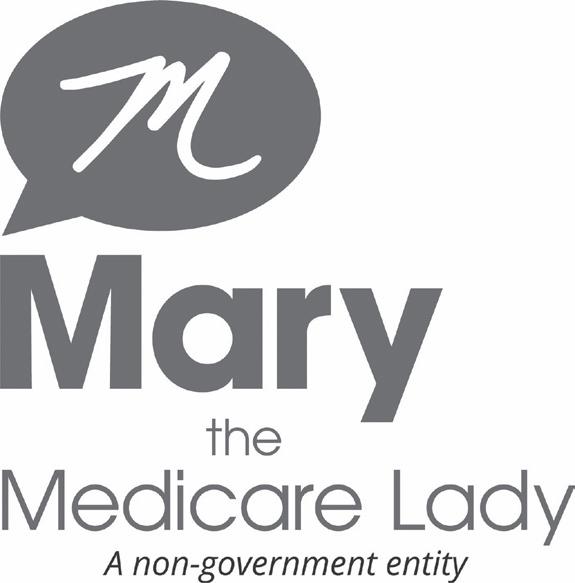
Human Services, July 8, 2003
The medical, personal, and social services necessary because of an accident, a chronic illness, a disability, or simply the phenomenon of aging—services associated with long-term care—are among the most expensive of health care costs. The actual cost of long-term care depends on where the care is received, what type of provider administers the care, and how long the care is required. Some people require minimal assistance with only a few Activities of Daily Living for a limited time. Others require skilled nursing facility care for an extended period. Unfortunately, no one can predict who will be stricken with the need for long-term care, what type of care will be needed, or how long the care will be necessary.
According to a Genworth Cost of Care Survey here are some median costs as of 2023.
Home Health Aide- provides assistance with Activities of Daily Living such as bathing, dressing, toileting, feeding, mobility, and transferring. Does not provide any medical care: $75,500/ year.
Adult Day Care — provides therapeutic, social, and other support services in a community-based setting: $21,515/year.
Assisted living facilities—a private one-bedroom unit in an assisted living facility, excluding any entrance or community fees: $64,200/year.
Skilled Nursing Facility/ Nursing homes— a semiprivate room is $104,025/ year and a single-occupant private room is $116,800/ year. Considering that the average length of stay in a nursing home is two and a half years, the total cost of an average stay would be about $260,000 to
$292,000. For many, this expense could easily consume a lifetime of savings. Others may not be able to cover the cost at all.
Generally, the public does not have a good understanding of the long-term care need, including why and how to plan for long-term care. Many simply deny that they will need long-term care; others believe, incorrectly, that Social Security, Medicare, or their existing (non-Medicaid) health insurance will cover the costs. They do not see long-term care as something one needs to plan for in advance, such as they would plan for retirement.
A report issued by the U.S. Department of Health and Human Services cited the following as key factors limiting demand for longterm care insurance:
• Lack of information— Many underestimate the likelihood of requiring Long Term Care services. Some are not aware of the tremendous costs of this care.
• Misperception of public and private programs— Many people believe that Medicare, retiree health plans, Medicare supplement insurance, or Medicare Advantage covers LTC services. This is not the case.
• Delayed preparation for/ denial of long-term care needs—Many do not think about preparing for longterm care needs until the need arises. People tend not to think about becoming older and needing care, or they don’t anticipate that they will ever need care themselves; they resist the idea of becoming dependent.
• Long lag time between purchase and benefit payment—Long-term care insurance must be purchased before it is needed; often, this means a period of many years between purchase and when benefits are likely to be paid.
• Affordability—Longterm care insurance can be expensive. Many of today’s older consumers with middle to low incomes cannot afford the premiums. (Don’t worry, options will be discussed in a future article.)
• Perception of need—
--Medicare continued on page 11.
By Dr. Naga Pannala.
An apple a day keeps the doctor away.”
You’ve probably heard that old saying, but what about this one: “An aspirin a day keeps heart attacks at bay?”
For years, that seemed like a prescription for good senior health. Doctors knew aspirin reduces the chance that blood clots will form and cause a heart attack or stroke. So they told patients to take a daily low-dose aspirin (typically 81mg), even if they weren’t in a high-risk group. As of 2021, 30% of adults ages 60 and up were doing just that.
Aspirin therapy sounds pretty harmless. It might even seem like one of those “can’t hurt, might help” recommendations. After all, you might ask, how dangerous can a baby aspirin be?
Pretty dangerous, it turns out.
Taking aspirin daily can cause bleeding in your stomach and intestines, among other problems. Symptoms of gastrointestinal bleeding include vomiting blood, feeling lightheaded or having black, tarry stools. These problems can happen even with coated aspirin, which is designed to pass through the stomach without dissolving.
In 2022, the United States Preventive Services Task Force (USPSTF) rec-
ommended against using low-dose aspirin to prevent cardiovascular disease (CVD). In fact, they gave aspirin therapy a D grade for adults 60 and up. (They gave aspirin therapy a C grade for adults 40 to 59, with at least a 10% chance of developing CVD in the next 10 years.)
What’s the USPSTF, you ask? It’s a group of experts in preventive medicine and primary care who make recommendations based on research findings. In this case, they looked at dozens of research studies. Some of those focused on the benefits of aspirin therapy; others focused on its risks.
The USPSTF recommendation only applies to people who don’t show any signs or symptoms of CVD. That’s an important point. The group didn’t say that aspirin therapy is always bad — just that it shouldn’t be used by most healthy people.
Your doctor may still recommend aspirin therapy if:
• You’ve had a heart attack or stroke,
• You’re at risk of having another one, and
• You’re under 70 years old.
However, aspirin therapy is a bad idea in these cases:
• You have an aspirin allergy or intolerance.
• You’re at risk for gastrointestinal bleeding or hemorrhagic stroke.
Medicare continued from page 10.
Some consumers decide they do not need long-term care insurance because they have too few assets to protect or have family and friends available to provide care. They may underestimate the time and toll that future caregiving will demand of their family or friends.
Given the likelihood of needing longterm care and the tremendous cost that this care entails, it is important that individuals plan for it—and the sooner the better.
Advanced planning:
• Will allow for greater independence and choice as to where and how the care is delivered.
• Can mean greater financial security, not only for those who may need care but also for their family and loved ones.
• Can ease the financial and emotional toll on one’s family and release them from the burden of providing the care, if and when it is needed.
• Will avoid the uncertainty, confusion,
• You regularly drink alcohol.
• You plan to undergo a simple medical or dental procedure (because of the risk of excess bleeding).
Note: most adults can still take aspirin occasionally to treat headaches, body aches and fever. Of course, your pharmacy also offers several other drugs that can treat those conditions.
Whatever you do, don’t start — or stop — taking a daily baby aspirin without talking with your doctor first.
Aspirin therapy isn’t the only way to prevent heart attack and stroke. You should also:
• Eat a healthy diet
• Maintain a healthy weight
• Get regular physical activity
• Avoid smoking
• Limit alcohol consumption
• Keep your blood pressure under control
• Keep your diabetes under control
Of course, those things help you in lots of other ways, too.
A Word from ArchWell Health: Wherever you are on the memory loss journey, you are not alone. The compassionate team at ArchWell Health is always ready to assist caregivers and older adults with their primary care needs.
and mistakes that could arise in the event of a health care need.
• Will promote a continued quality of life, as the person defines it, when care is needed.
Having a plan in place can make all the difference. Understanding care options, exploring financial resources, and starting the conversation early can help individuals make informed decisions. After all, aging is inevitable. But facing it unprepared doesn’t have to be.
Mary Hiatt is President of Mary the Medicare Lady (A non-government entity.) She is a member of a pharmacist-led organization that helps her clients source savings for medications. She offers Educational Workshops on Medicare, Drug Savings, How to Stop Phone Calls, and more at no charge. Not connected with or endorsed by the U.S. government or the federal Medicare program. See www. hiattagency.com or contact licensed independent agent mary@hiattagency.com or call or text 402-672-9449 for more information.
The number of pedestrians killed on United States roads and streets has increased by more than 80% since reaching its modernera record low in 2009.
While the contributions of factors such as vehicle size and driver behavior have been the subject of extensive research, two additional factors also stand out: time of day and location.
Virtually the entire increase in pedestrian fatalities since 2009 has taken place in darkness, and the vast majority of it has been on urban arterial roads.
The purpose of this study was to investigate factors contributing to pedestrian fatalities in darkness on urban arterial roads, to increase awareness of the issue among transportation professionals as well as the public, and to build support for effective countermea-
sures to reverse the increasing trend.
The research team performed an in-depth investigation of a representative pedestrian fatality in Chapel Hill, NC, using a formal process designed to identify not only the most proximal contributing factors (e.g., road user behavior) but also broader social, environmental, and policy factors that set the stage for such a crash to take place.
The investigation included in-person examination of the crash scene and video of the crash, review of the police crash report and related media reports, and consideration of relevant local, state, and federal policies, programs, and plans.
Analysis of local crash data, policy scans, and interviews with city officials
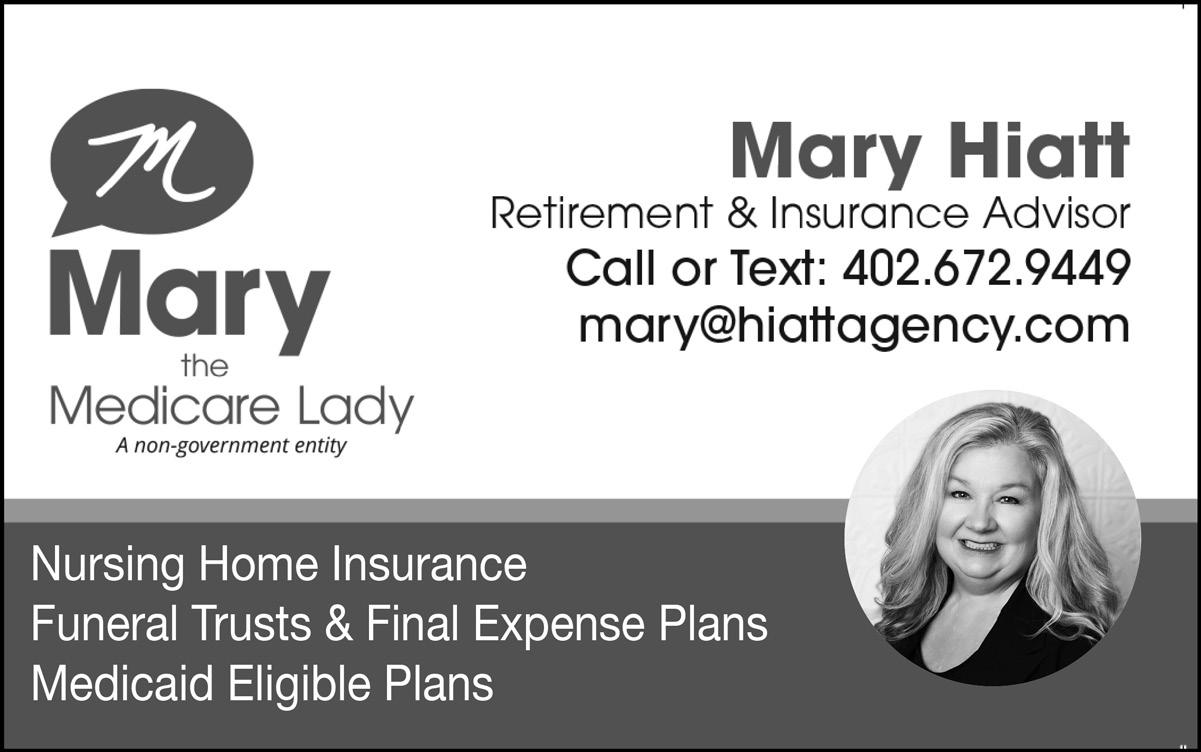


were used to examine the characteristics of locations and neighborhoods where pedestrian injuries and deaths occurred, as well as the policy landscape related to pedestrian safety in each city. The report discusses the findings of the crash investigation and case studies in the context of the current body of evidence regarding pedestrian safety and measures to improve it.
The results of this study highlight the many complex and interconnected factors influencing pedestrian fatalities on urban arterials at night. The on-scene investigation provided many insights likely to be applicable beyond the one specific crash examined.
Additionally, pedestrians are required to walk several hundred feet along a poorly lit road without a continuous sidewalk to reach the nearest marked crosswalk. The research also revealed policy-level factors influencing safety at the crash location. For example, arterial roads
in many cities are owned and controlled by the state; local officials are often unable to make changes to or implement countermeasures on these roads. Even on city-controlled roads, pedestrian safety efforts tend to be focused in and around the city centers, whereas a substantial proportion of pedestrian injuries and fatalities occur well outside city centers. The case studies identified several common factors associated with pedestrian injuries and fatalities in the three cities examined. Most notably, a large majority of pedestrian fatalities occurred on arterial roads and many occurred in darkness, which aligns with national trends. A far greater proportion of pedestrian fatalities than non-fatal injury crashes occurred on arterial roads in darkness. In all three cities, crashes occurred disproportionately in socially and economically disadvantaged neighborhoods. In recent years, the concentration of crashes in more disadvantaged neighborhoods has
increased. Pedestrian crash and fatality rates also tended to be higher in neighborhoods with older housing and greater diversity of land use. In all three cities, more than half of all pedestrian fatalities were more than 4 miles from the city center and have, in recent years, moved further from the city center in two of them. The policy scan in Charlotte, Memphis, and Albuquerque identified some crucial challenges to improving pedestrian safety. These included the high cost of fixing the arterial networks, tensions between roads designed for vehicle throughput and pedestrian safety, the local challenges of implementing interventions on statecontrolled roads, and public resistance to change.
The AAA Foundation for Traffic Safety in Washington, D.C., is a nonprofit, publicly supported charitable research and educational organization dedicated to saving lives by preventing traffic crashes and reducing injuries when crashes occur.
Ever been in a rotten mood when nothing goes right? Maybe you spilled your coffee or stubbed your toe. Did you instinctively think, “This day is ruined,” or, “It can only go up from here!” Dictionary.com defines hope as “the feeling that what is wanted can be had or that events will turn out for the best.”
A hopeful you is a healthier you. Hope is an active approach to bettering your life, pursuing your goals and lifting your spirits. The American Psychological As-

sociation states that remaining hopeful during tough times can reduce stress, depression and feelings of helplessness. Even if it feels easier to curse at the world on a crummy day, painting your present and future in a positive light will help inspire you to overcome obstacles.
Hope makes the world a better place. Spreading hope is just as important as having it. By extending your optimism to those around you, you make the world brighter. Spreading hope doesn’t have to be a massive gesture—it can be as simple as spending quality time with your loved ones or doing an act of kindness for a stranger. Your actions may motivate others to maintain hope in their own lives, leading to a domino effect of positivity in your social circles, communities and the world as we know it.
Staying hopeful will help you live joyfully, age gratefully. Studies have been conducted on the effects hope has on aging. By living with a hopeful mentality, older participants recorded
lower risks of mortality, cancer and decreased psychological distress. Additionally, an Oxford study discovered that younger generations may have more positive outlooks on aging after witnessing older adults who live life with hope and a sense of purpose.
Having a hopeful disposition will open many doors in your future. Even if there is a day when you shatter your most cherished mug, there will be another day where you’ll discover a new favorite. Think of this as you face challenges throughout life. As you endure hardship, keep going. By thinking of the good days to come, you will eventually be led right to them.
This health tip is brought to you by Tabitha. Tabitha offers a range of services in Western Minnesota, North Dakota and Nebraska from results-driven rehabilitation, accessible at-home home health care, innovative living communities and compassionate hospice services. Visit Eventide.org and Tabitha.org to learn more.
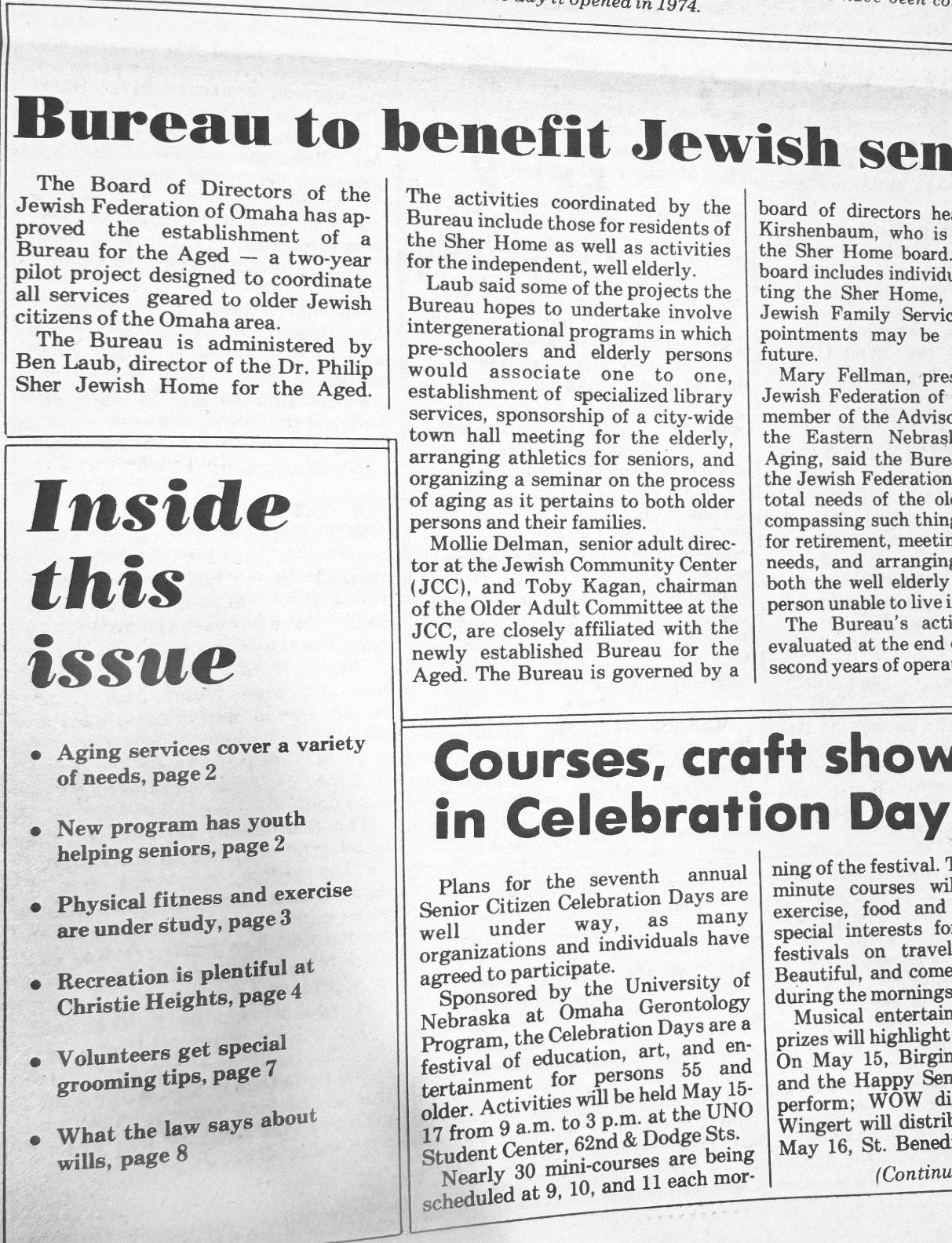
In the April of 1979 issue of the New Horizons, an article was published about the establishment of Bureau of the Aged, which was a two-year pilot project designed to coordinate all services geared to older Jewish citizens of the Omaha area.
How many times in a day do you say, “My body’s not what it used to be!” Whether it’s an achy joint, a finicky muscle or a random pain, most folks come to the realization that they’re not as spry as they once were.
To help you live joyfully, age gratefully, here are some tips for Athletic Training Month to help you kick-start your proactive wellness journey.
Train your endurance. Anyone and everyone can benefit from endurance training. According to Heart. org, endurance benefits your whole body and can keep critical systems like your heart and lungs in tip-top shape. It can also boost your energy.
Start by doing aerobic exercises like swimming, dancing or walking at a brisk pace. If you’re
strength training, focus on low intensity, higher repetition exercises at whatever weight is comfortable to you.
Take time to get a good stretch in. Everyone should incorporate flexibility exercises into their life — you don’t have to end up in the splits, but training your range of motion as you age will greatly benefit your body. Stretching is a widely inclusive activity; it can include anything from doing yoga, reaching down to your toes, or doing stretches while seated or in a wheelchair. The internet has countless flexibility routines customized for anyone.
Find your balance. Not only are we talking about avoiding overexerting yourself while you’re starting out, but working on your balance actually improves
other aspects of your overall physical strength, not to mention that it will prevent your risk of falling and potentially causing an injury. Find your dominant leg and get started with one-leg stands, heel-to-toe walks, stair step-ups or any balance exercises that fit your range of motion.
Plenty of these exercises can be done in the comfort of your own home, but if you think you may want or need a little help, rehabilitation programs like Tabitha LifeQuest exist not only to help in the case of an injury, but also to help you prevent any future harm by ensuring your body is working as it should. And just remember: The hardest part about any wellness routine is starting.
This health tip is brought to you by Tabitha.
The CAPACITY Lab in the Department of Gerontology at UNO is looking for healthy adults, and caregivers to an older adult with a chronic disease (e.g., dementia, cancer, cardiovascular disease), to participate in a research study about the impact of aging on the neural and behavioral bases of social processing.
The study will include an online, at home component (7 hours over 4 days), and one in person visit (2 hours, 30 minutes), which will take place at the University of Nebraska Medical Center (UNMC). There will be an experiment that involves an online questionnaires and interview, computer tasks, saliva collection (for hormone analyses), blood draw, and brain imaging. Compensation for study participation is available. Parking is complementary and located a short walk from the building where the experiment will take place.
Do you qualify? They are looking for adults between the ages of 19-90 years, you must have comprehension of written and spoken English, have mobility to travel to UNMC to participate and you must have completed a minimum of two years of high school or higher.
The second study is about recruiting family caregivers for older adults with dementia.
The study will include two in-person visits of approximately three hours each that will take place at the University of Nebraska at Omaha (UNO) and the University of Nebraska Medical Center (UNMC). The study involves completing questionnaires, interviews, and tasks, a blood draw, and brain imaging. Parking is complementary and located a short walk from the building where the experiment will take place. Compensation for study participation is available.
To qualify, you must be an adult between 45–75 years of age, female, right-handed, and currently an unpaid family caregiver to an individual with Alzheimer’s disease, frontotemporal dementia, vascular dementia, or Lewy body dementia for at least 10 hours a week and for at least 6 consecutive months.
You must have comprehension of written and spoken English, have normal or corrected to normal hearing and vision, have mobility to travel to UNO and UNMC and must have completed a minimum of two years of high school or higher.
If you are interested please call 402-554-2951 or email Janelle Beadle, Ph.D. at UNOCapacity@unomaha.edu.
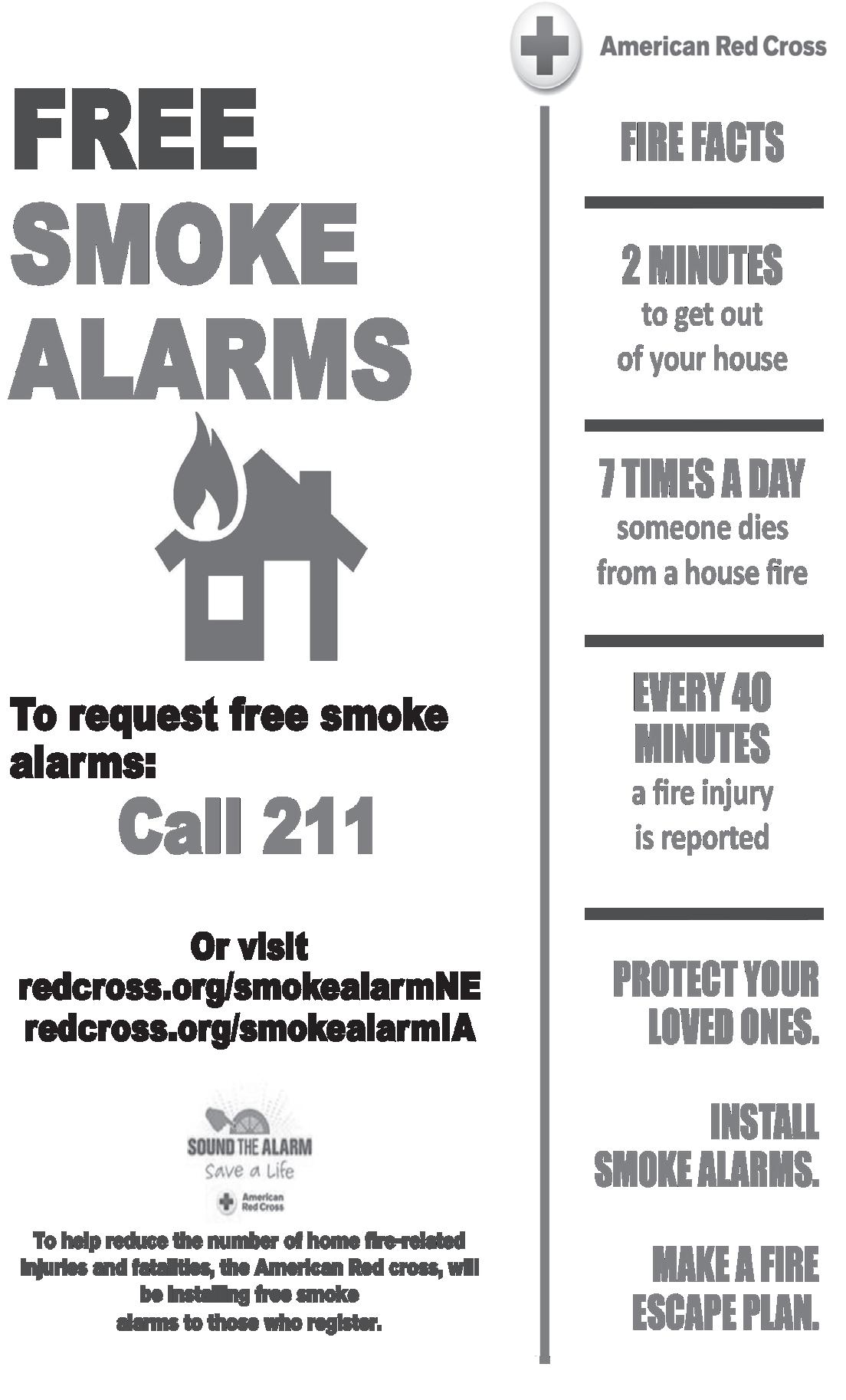
By Mike Carsey Volunteers Assisting Seniors
Managing your medication costs is an important part of Medicare. This should be a joint effort between you and your prescribing provider. You team with your provider and your provider works with you. When you see a provider, you should have a level of trust. The provider should take the time to know you, your health history, be a good listener, and allow you to participate in your healthcare decisions. This is especially important when medications are prescribed. Know what the medication is supposed to do to help you with your health condition. What are the objectives the prescribing physician is trying to achieve? What can you do to help achieve those objectives besides taking the medication as prescribed?
Asking questions and taking notes during your visit is a great way to become an active participant in your healthcare decisions.
As a result of certain provisions of the Inflation Recovery Act, the coverage gap or “donut hole” is gone effective. The most any Medicare beneficiary will pay for their medications in 2025 is $2000. This is called the $2000 cap. This cap applies ONLY for medications that are on the formulary of your plan. The cap does not include the
premium you pay for your plan.
If you take medications that are not covered by Medicare, the cap is not applicable. Medications not covered by Medicare drug plan formularies can be expensive. If you have such a medication, you should discuss an alternative with your prescribing provider or investigate a Patient Assistance Program (PAP) for that medication. PAPs are programs offered by the manufacturer of the medication. The manufacturer may work directly with you or use a charitable foundation to provide a PAP. These programs require an application, usually documentation from a provider regarding your treatment plan, and are income based. PAP’s can offer significant savings to the medication cost. Your prescribing physician will often have details about the PAP program for the medication prescribed. Your plan is also required to offer a capped monthly installment payment plan instead of paying for your medications up front at the pharmacy. Your plan can provide details about how the payment plan might work for you. The payment plan is interest free.
Are you frustrated with the cost of some of the medications you take even though you are enrolled in a Medicare part D drug plan
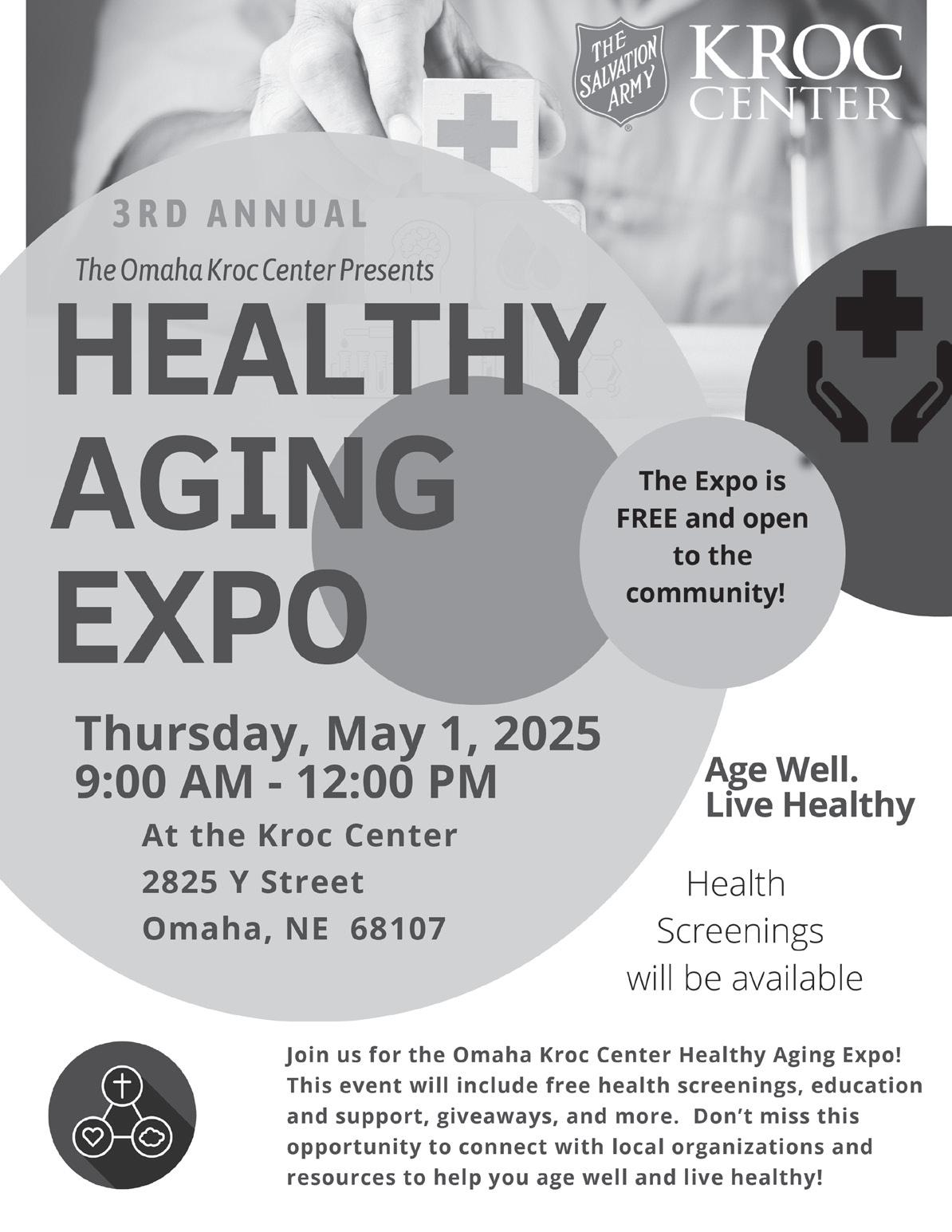
or a Medicare Advantage plan which includes part D medication coverage? It is true. Some medications that we take are just not covered very well by the part D drug plans. Some may not be covered at all. Many brand name and specialty medications can be very pricey for us.
Medicare Advantage plans, including part D drug coverage, and/or part D stand-alone drug plans, in most cases, cannot be changed until the Annual Open Enrollment Period in 2025 which begins October 15 and ends December 7. This does not mean that, as a beneficiary, you are without options to help manage your plan throughout the year. Ideas for managing your medication costs will appear in bold print.
Each part D plan has an extensive formulary. Most of the common medications we take are included in the plan formulary. Federal law requires plans to include at least two drugs from each class of drug category on its formulary. Most plans cover many more than two options.
Often during the year, we experience changes to medications that are prescribed. When your provider prescribes medications, be sure and ask for generics. This may seem obvious, but there are nuances within your part D plan of which you may not be aware.
Most Part D plans use a tiered formulary. Tiers are a method by which plans classify drugs by cost and determine copays and coinsurance amounts. Plans generally have five or sometimes six tiers. Tier 1 and 2 are usually generic tiers, tier 3 is usually for brand name medications and tiers 4, 5, and 6 are generally for specialty medications. The tier classification used by your part D drug plan can make a difference in the copay or coinsurance you must pay for the medication. If you have an expensive copay due to a tier classification, you may be able to request a tier exception. Talk to your pharmacy and ask if your copay is high because your prescription has been placed in a higher tier by your plan compared with similar drugs on the formulary. You generally will not be able to request a tier exception

if the medication you take is a specialty medication. Contact your part D plan to request a tier exception. Your prescribing physician may be able to provide you with a letter supporting your request. Your plan must give you a decision within 72 hours of receiving your request. If you take expensive medications and a tier exception is not a possibility, there are other courses of action for you to investigate. The State of Nebraska and the Federal Government offer programs to help offset some of the costs you may incur.
Medicaid, administered by the State of Nebraska, offers two levels of assistance: Full Medicaid and Partial Medicaid. Both levels will assist beneficiaries in not only reducing copays for medications but also help offset other healthcare and Medicare costs. Qualification is determined by income and asset guidelines.
2025 MEDICAID AND LOW-INCOME SUBSIDY (LIS) GUIDELINES: FULL MEDICAID ELIGIBILITY GUIDELINES
Individuals having incomes less than $15,660 annually or $1,305 monthly with assets totaling no more than $4,000 (not including car and home).
Married couples living together having incomes less than $21,156 annually or $1,763 monthly with assets totaling less than $6,000 (not including car and home).
Qualification for Full Medicaid provides healthcare benefits as well as co pays of no more than $4.90 for generics and no more than $12.15 for brand name medications. These copays are for 30-day supplies.
Partial Medicaid Eligibility Guidelines: Individuals having incomes less than $21,372 annually or $1,781 monthly with assets totaling no more than $9,660 (not including car and home).
Married couples living together having incomes less than $28,800 annually or $2,400 monthly with
assets totaling less than $14,470 (not including car and home)
Low Income Subsidy (LIS) Eligibility Guidelines: LIS is sometimes called “Extra Help” and is administered by Social Security. This is a federal program. Eligibility for this program is also determined by income and asset guidelines.
Individuals having incomes less than $23,712 annually or $1,976 monthly with assets totaling no more than $17,600 (not including car and home).
Married couples living together having incomes less than $31,968 annually or $2,664 monthly with assets totaling less than $35,130 (not including car and home).
Qualification for either Low Income Subsidy or Partial Medicaid offer several benefits including copays of no more than $4.90 for generic medications and copays of no more than $12.15 for brand name medications. These copays are for 30-day supplies.
If your income is above these guidelines, you may have other options. For many medications, Good Rx or Single Care websites will offer coupons which may have better pricing for a medication than your Part D plan offers. It is ok to use a Good Rx or Single Care coupon to purchase your medication and use your Part D plan for all other medications. These coupons are accepted by most pharmacies but be sure to check with your pharmacy for coupon acceptance. Often your pharmacy can assist you in determining if either Good Rx or Single Care offer less expensive pricing than your Part D plan.
Volunteers Assisting Seniors (VAS) can help you investigate the options and assist you in determining whether you may be eligible for price reductions for your medications. Call our office at 402-444-6617 for more information. Follow Volunteers Assisting Seniors on Facebook at “VAS Nebraska.” Information about Medicare and Fraud are included. “Fraud Friday” is a feature providing the latest information about phone and email scams as well as other information about fraud.
Join Flaherty Senior Consulting for a series of Solutions Group gatherings that will address the questions and challenges caregivers face.
Solutions Groups provide opportunities for caregivers to learn how to deal with various issues, obtain skills and knowledge, engage in discussions, and interact with others in similar circumstances.
Upcoming meeting dates and locations are:
• April 3, June 5, Aug. 7, Oct. 2, Dec. 4
The Servite Center of Compassion 72nd St. and Ames Cr.
• April 16, June 18, Aug. 20, Oct. 15, Dec. 17
St. Timothy Lutheran Church 93rd and Dodge streets
• May 13, July 8, Sept. 9, Nov. 11
St. Vincent de Paul Church 14330 Eagle Run Dr.
• May 17, July 26, Sept. 27, Nov. 29 Faith Westwood United Methodist Church 4814 Oaks Ln.
The Solutions Groups are facilitated by Nancy Flaherty, MS, CDP, president of Flaherty Senior Consulting. She has extensive experience working with family caregivers and caregiver groups.
For more information, email Nancy at flahertyconsulting@cox.net or call/text her at 402-312-9324.
The Eclectic Book Review Club, founded in 1949, is announcing its Spring 2025 schedule of author appearances. Each event includes readings and discussion by the noted book’s author. New members are being accepted. The monthly meetings, which include lunch and the author book review, are held at noon at The Field Club of Omaha, 3615 Woolworth.
To reserve a seat, call Jo Ann at (402) 571-5223.
Reservation deadline is the Friday morning prior to the Tuesday meeting.
Authors for spring 2025 include:
• April 15- Carolina Hotchandani is an author, poet, and the Goodrich Assistant Professor of English at the University of Nebraska-Omaha. She will share her poetry book The Book Eaters. This debut book has been recognized with the Nebraska Book Award for Poetry.
• May 20- Timothy Schaffert, a professor of creative writing and the author of numerous books will present his most recent title, The Titanic Survivors Book Club. This tale focuses on the life-changing power of books, following the Titanic librarian whose survival upends the course of his life.
Life can bring on stress for many of us. Finding ways to relieve stress is important to our overall health and wellbeing. Caregivers are not immune to this stress.
Please contact Respite Across the Lifespan at edbennett@unmc.edu or 402-559-5732 to find out more about respite services and to locate resources in your area.
The 18th Annual Omaha Health Expo is shaping up to be a fantastic event for anyone interested in health, wellness, and fitness.
This year, it will take place on April 12-13 at the Oak View Mall (144th and Center). The Expo is the largest showcase in the Omaha area for products and services focused on improving physical and mental well-being.
If you’re curious about new ways to boost your health, reduce pain, explore alternative medicine, or discover organic foods and green living, this is the perfect event. Plus, there will be experts and vendors ready to offer personalized advice on a wide range of topics—from yoga and meditation to the latest in health tech.
Mike Mancuso, the Director of the
Omaha Health Expo, emphasized that this event is all about education and interactive learning, with seminars on various topics both days. Whether you’re seeking ways to manage arthritis or want to explore natural supplements, this expo brings everything under one roof. Attendees will also get the chance to speak with industry professionals about health and wellness.
This is a fantastic opportunity to connect with experts, learn about new health technologies, and find holistic approaches to improving your quality of life. There will be free admission and parking.
For more information, or if you’re interested in becoming an exhibitor or sponsor, visit the Omaha Health Expo website or contact the Show Director at 402-3468003.
In the United States, thousands of people have lost their homes in California’s recent wildfires. The fires have caused billions of dollars in damages, and cybercriminals are trying to exploit this unfortunate situation. In this week’s scam, cybercriminals contact you by email, phone, or even in person. They claim to be federal officers who can help you receive grant money to rebuild your property.
The cybercriminals tell you that in order to receive financial aid, you have to pay them fees. Even worse, they ask for information such as your Social Security num-

ber and address so that they can steal your identity. If you pay their fees, you won’t receive any grants to repair your property. Instead, your money goes straight into the cybercriminals’ pockets, and your identity will be stolen.
To avoid falling victim to a disasterrelated scam, check official government websites for legitimate disaster relief information. Be wary of unsolicited emails, phone calls, or door-to-door visits offering disaster relief.
For more information, visit KnowBe4. com.




By Ron Petersen
Dog lovers around the world, love the fourlegged animal like it’s their best friend.
Just like any dog, therapy dogs in particular provide more than just companionship — they also offer a range of health benefits. From reducing anxiety to helping with physical rehabilitation, it’s clear that therapy dogs are a valuable resource.
“Therapy dogs have a place in this world — they provide comfort, and they provide great, mutual bonds,” Dog Training Elite owner of the Nebraska franchise, Bob Wiegand said. “Those truly in need, need to have something like a dog to cheer them up. It’s very important to have therapy dogs available to the public.”
Therapy dog visitation for older adults may improve their mental health significantly.
Dogs naturally make people happy and comfort those who need them.
Therapy dogs provide a more comfortable approach to interacting with many individuals who struggle to socialize or are lonely.
“It’s like making a new friend because they can ease the tension in the real world,” Wiegand said.

Therapy dogs can support human health and well-being in many ways, including: Reducing stress and anxiety, improving social skills, enhancing rapport, improving coping and recovery and increasing self-esteem. Therapy dogs are certified pets that are trained to provide comfort and joy to people in need. They are not allowed in public places, except when providing pet therapy.
Using language to describe oneself is sometimes difficult for people who require memory assistance at times. They also provide a calming impact that allows people to temporarily break through the barrier of Alzheimer’s disease to form a special bond.
Dogs are also there to help you without making judgments and are unconditional in their affection. The effects of therapy dogs range from anxiety and stress reduction to increased
self-esteem, which increased during the coronavirus pandemic.
“Getting back out and socializing has been difficult for some people. We train the dogs to be their companion and buddy,” Wiegand said.
Some older adults experience loneliness or sadness. One of the most amazing benefits of therapy dogs is their capacity to alleviate feelings of isolation and despair. Negative emotions are replaced by a valued com-

panion’s love and affection.
It’s not unexpected that contact with therapy dogs helps seniors better grasp meditation. Generally, meditation entails focusing all your concentration on the current moment’s pure experience.
“Therapy dogs’ demeanor is to be loving and happy,” Wiegand said. “Some retired people like to get therapy dogs to share the happiness with those in nursing homes or hospitals. People want us to train their dogs to be therapy dogs so they can pay it forward to the community.”
The goals of dog therapy might vary, and these will influence how it is implemented. Depending on the disease and the type of help required, the form of therapy and its objective may alter. Goals include:
• Socialization
• Motivation
• Decrease in stress, anxiety and depression
• Increase overall optimism
• Lower pain levels
• Provide comfort
• Promote healing
• Ease loneliness
Additionally, the dog’s trainer, generally the owner, brings the pet to every session as part of the therapy process. The owner should work with the person to assist them in accomplishing their therapy objectives under the supervision of a doctor. Also, the dog and the owner should go through different qualifications with these agencies and organizations before being approved for therapy utilization.
“The dog has to be liked to be handled. While it’s your own personal dog, not all dogs are cut to be a therapy dog,” Bonafide Dog Academy owner, Susan Bailey said. “You have to start training early on and the biggest thing is temperament. The dog has to be comfortable in a variety of situations.”
In persons with a variety of ailments, a therapy dog can considerably lessen pain, stress, sadness, and tiredness:
• Individuals who receive cancer treatments
• Dementia patients
• Anxiety patients
• People who have heart illness
People who are diagnosed with conditions aren’t the only ones who benefit. A therapy dog is also being implemented in non-medical situations to assist individu-
als in coping with stress and anxiety, such as in schools and outreach programs. Service dogs are trained to carry out certain activities on their handlers’ behalf. They go through extensive, high-end, task-oriented training to assist their owners with impairments. In this manner, a service dog varies from a therapy dog. Although therapy dogs are allowed to work and socialize with a diverse group of individuals, service dogs are taught to assist a single disabled person.
Comfort dogs are often known as therapy dogs. They provide comfort and affection to a person’s emotional well-being. Also, they are expected to interact with a wide range of people and should have a cheerful and welcoming attitude. A therapy dog’s function varies from dog to dog and organization to organization.
“The similarity in training therapy dogs to service dogs, is the obedience. When I say I want the dog to come, I want them to come. If I want them to stay, I want them to stay,” Wiegand said, “The difference is that therapy dogs are okay with leaving their handler’s side. A service dog is trained to be by the handler’s side all the time and not make friends. They can’t show any signs of aggression. One is designed to stay, and one is designed to leave.”
With some training, every friendly breed of dog might become a therapy dog. Generally, therapy dogs include golden retrievers, standard poodles, St. Bernards, and Labrador retrievers.
Similarly, smaller breeds like micro poodles and Pomeranians are ideal candidates whenever the dog and the patient share a tiny area.
Before being recognized as therapy dogs, canines are trained and monitored for their sensitivity to stresses such as loud noises, being suddenly grasped, or even equipment, including canes or wheelchairs.
The benefits of therapy dogs are vast and varied, making them an excellent resource for people in different situations.
Service dogs and therapy dogs provide different types of support, which is why it’s important to understand the difference between them. Dogs can offer emotional support, physical assistance, socialization opportunities, and more.